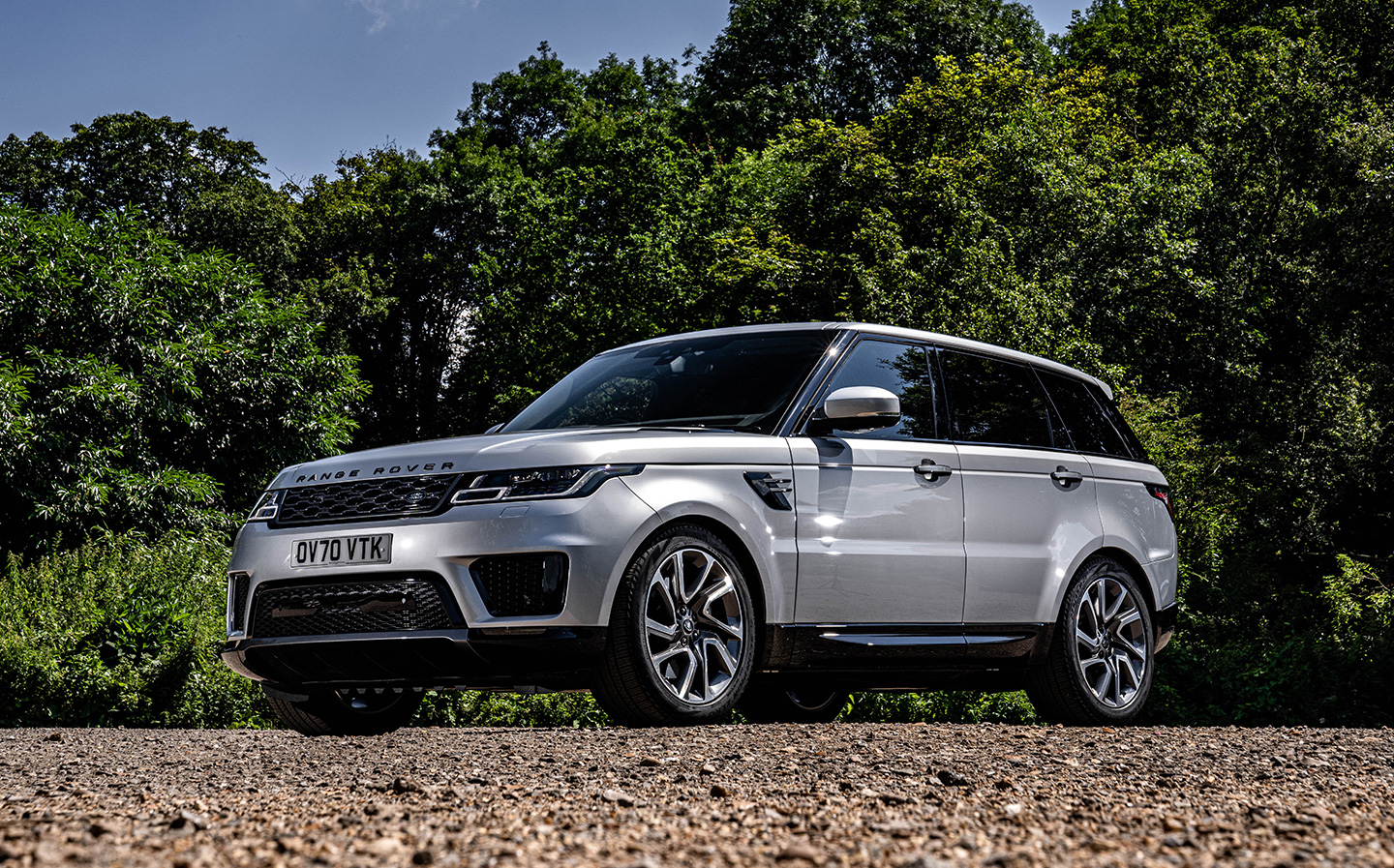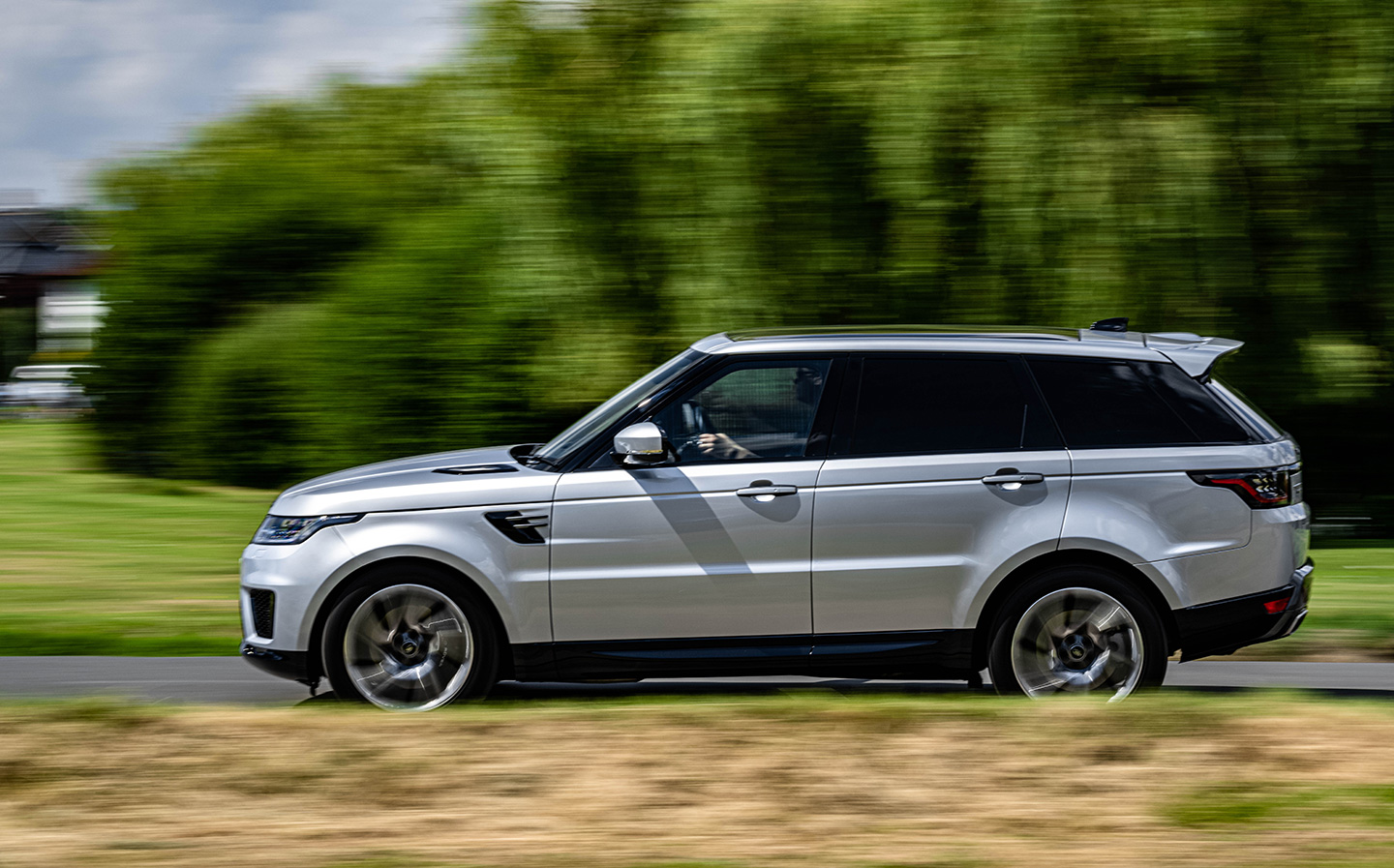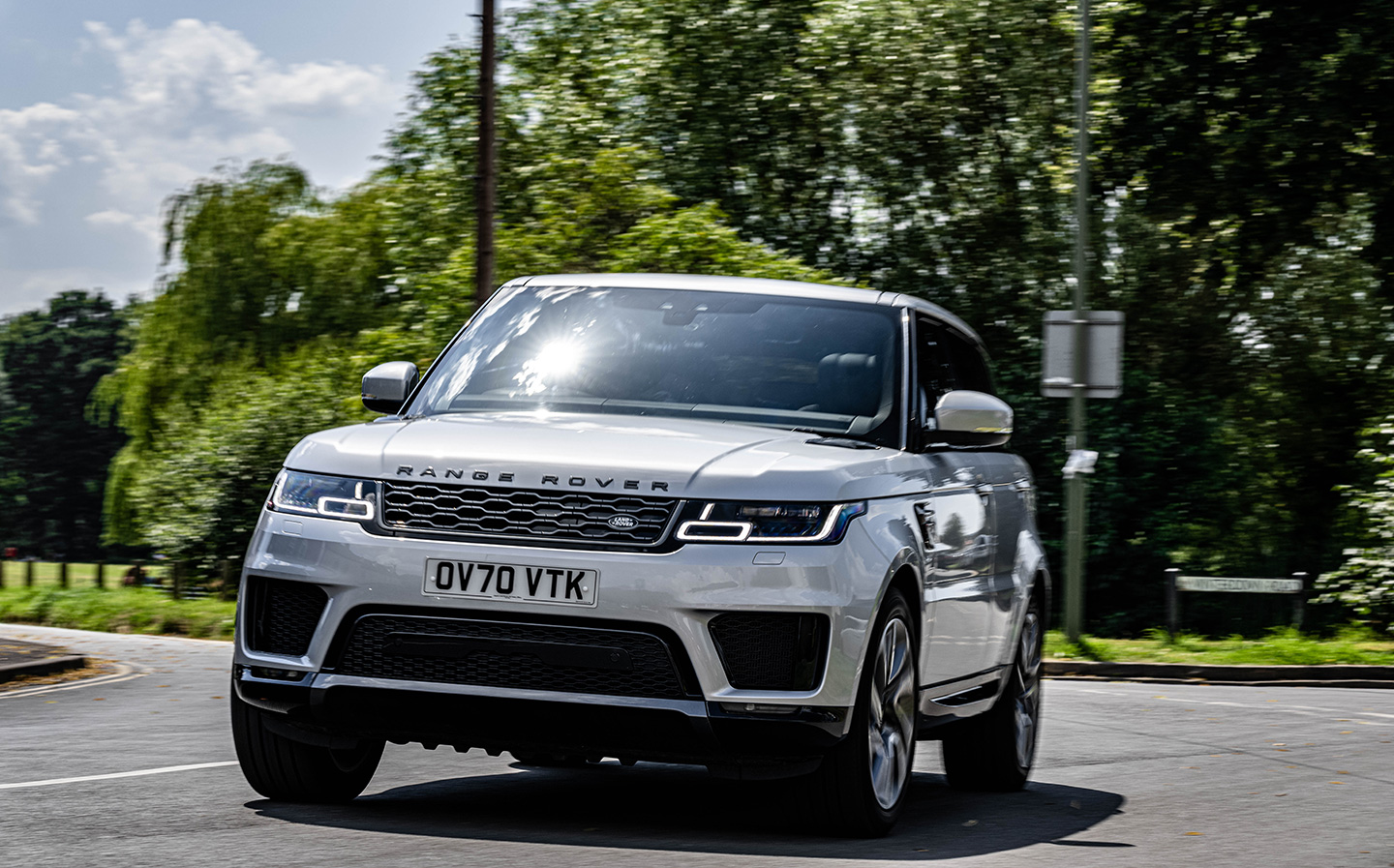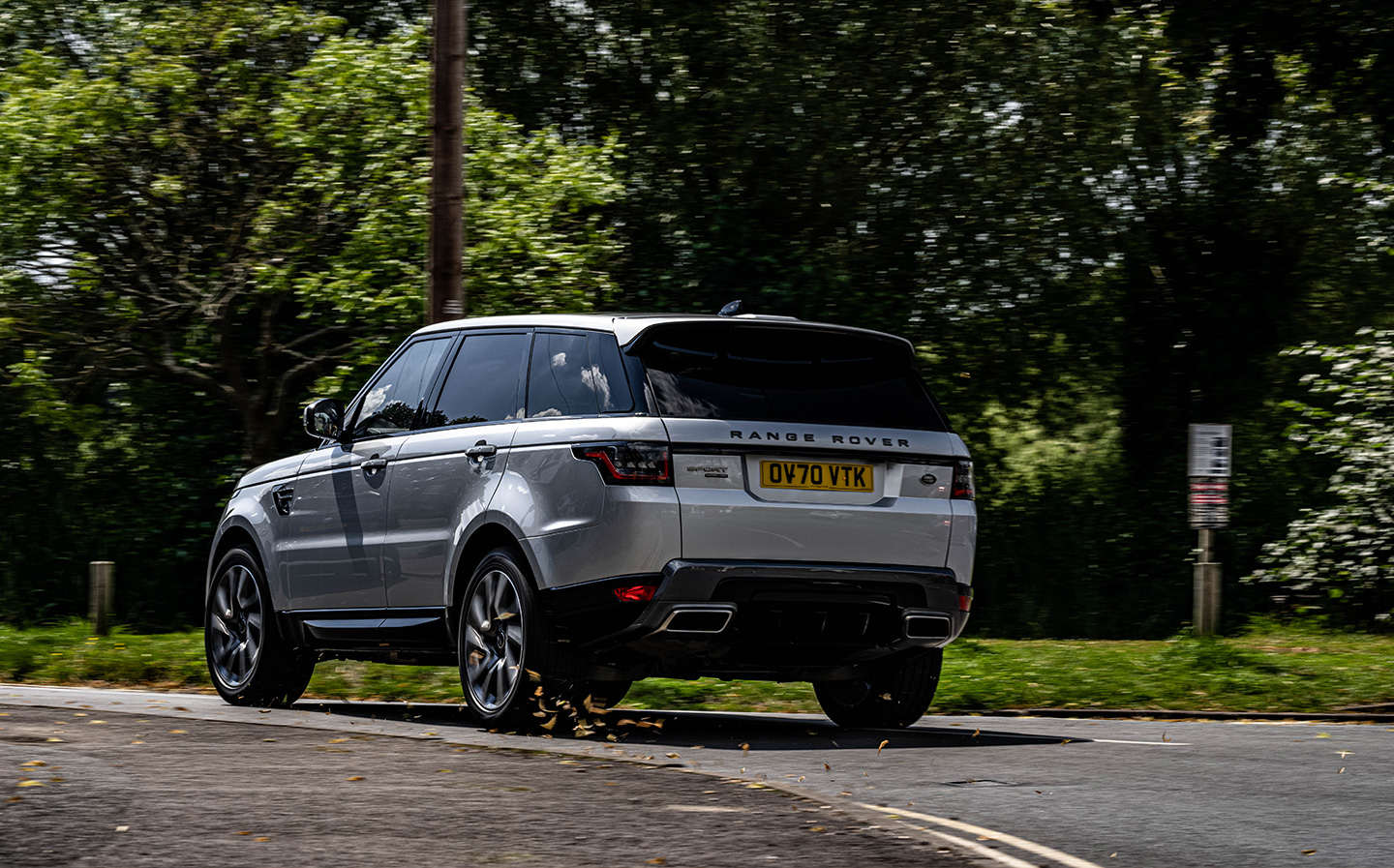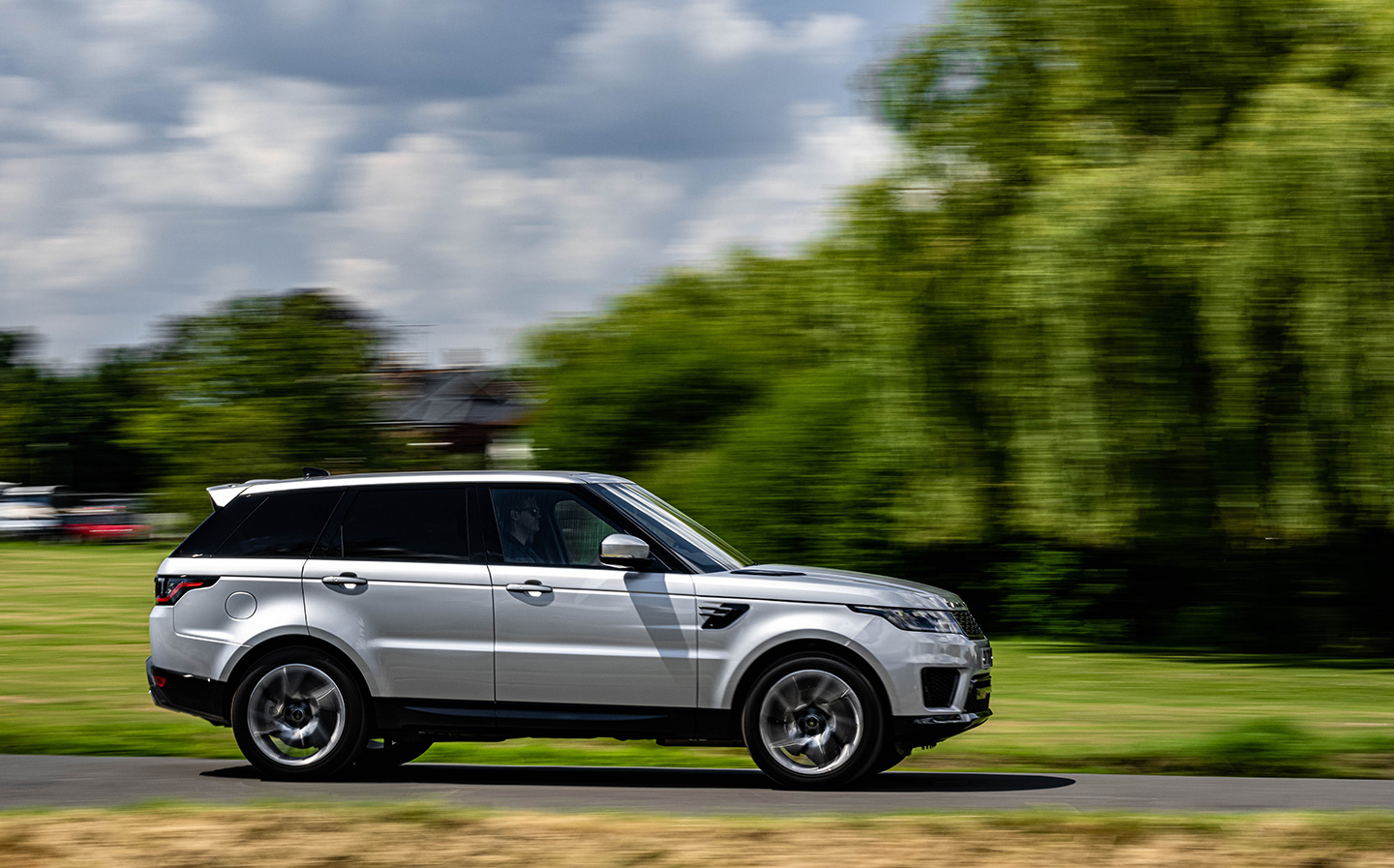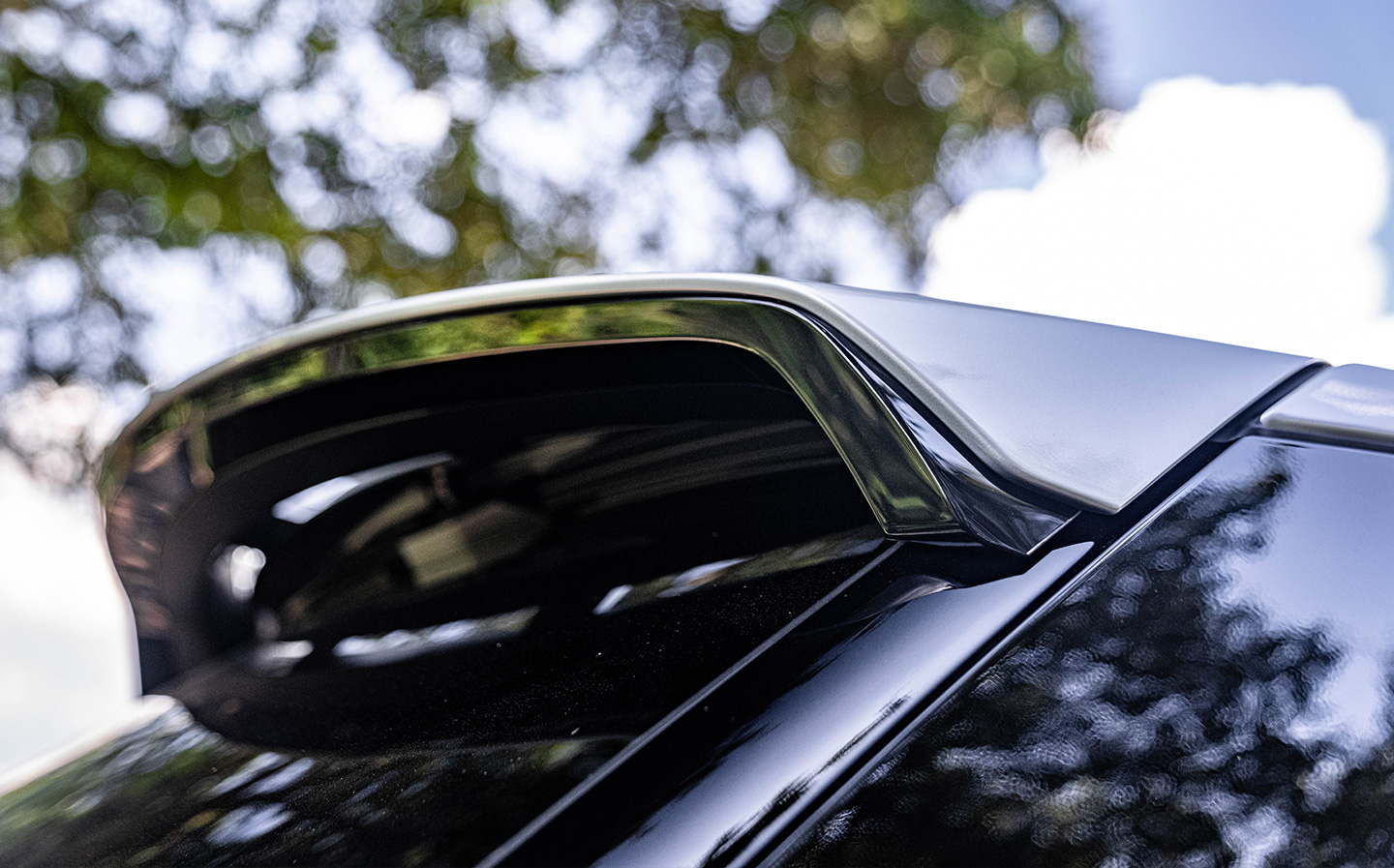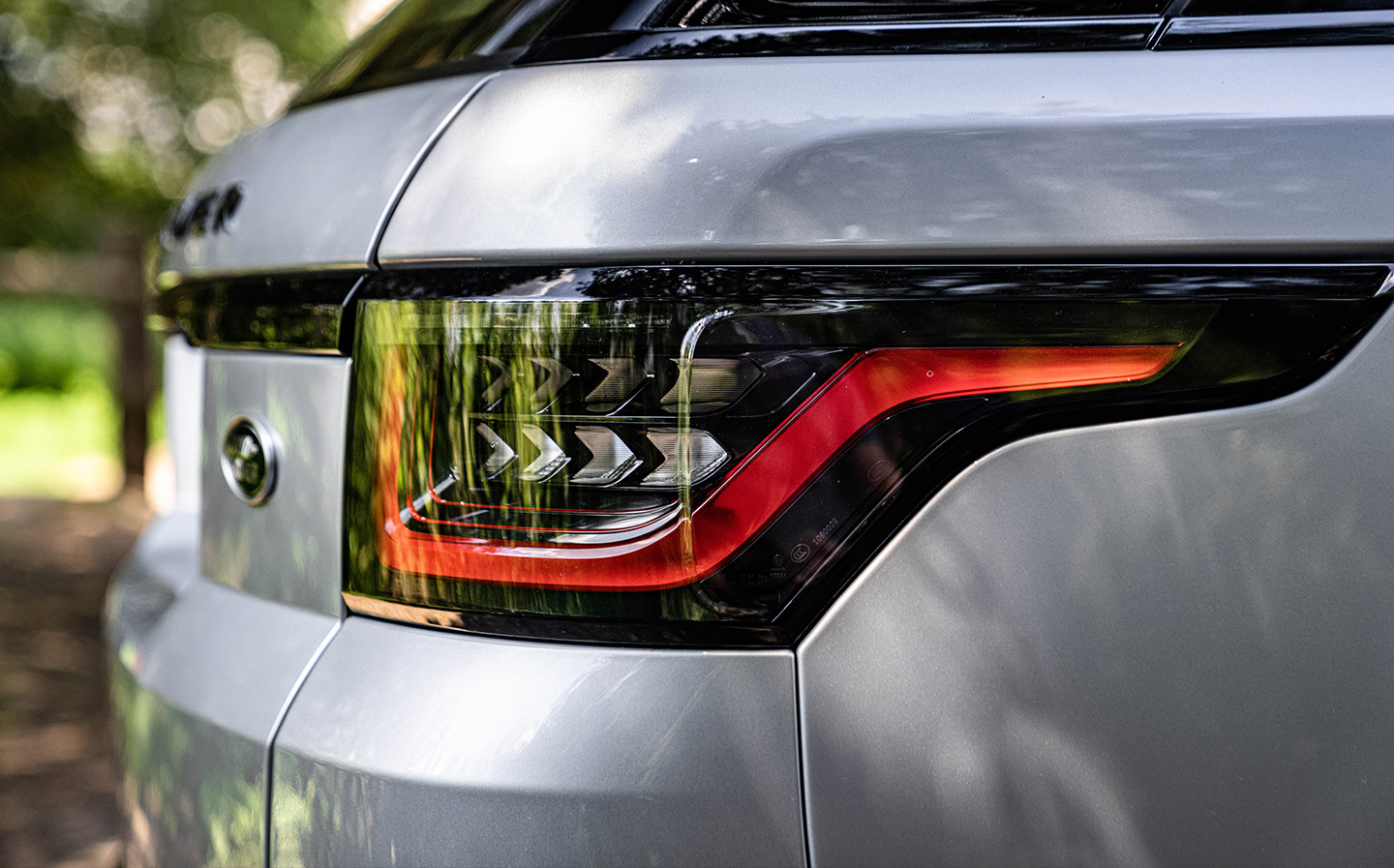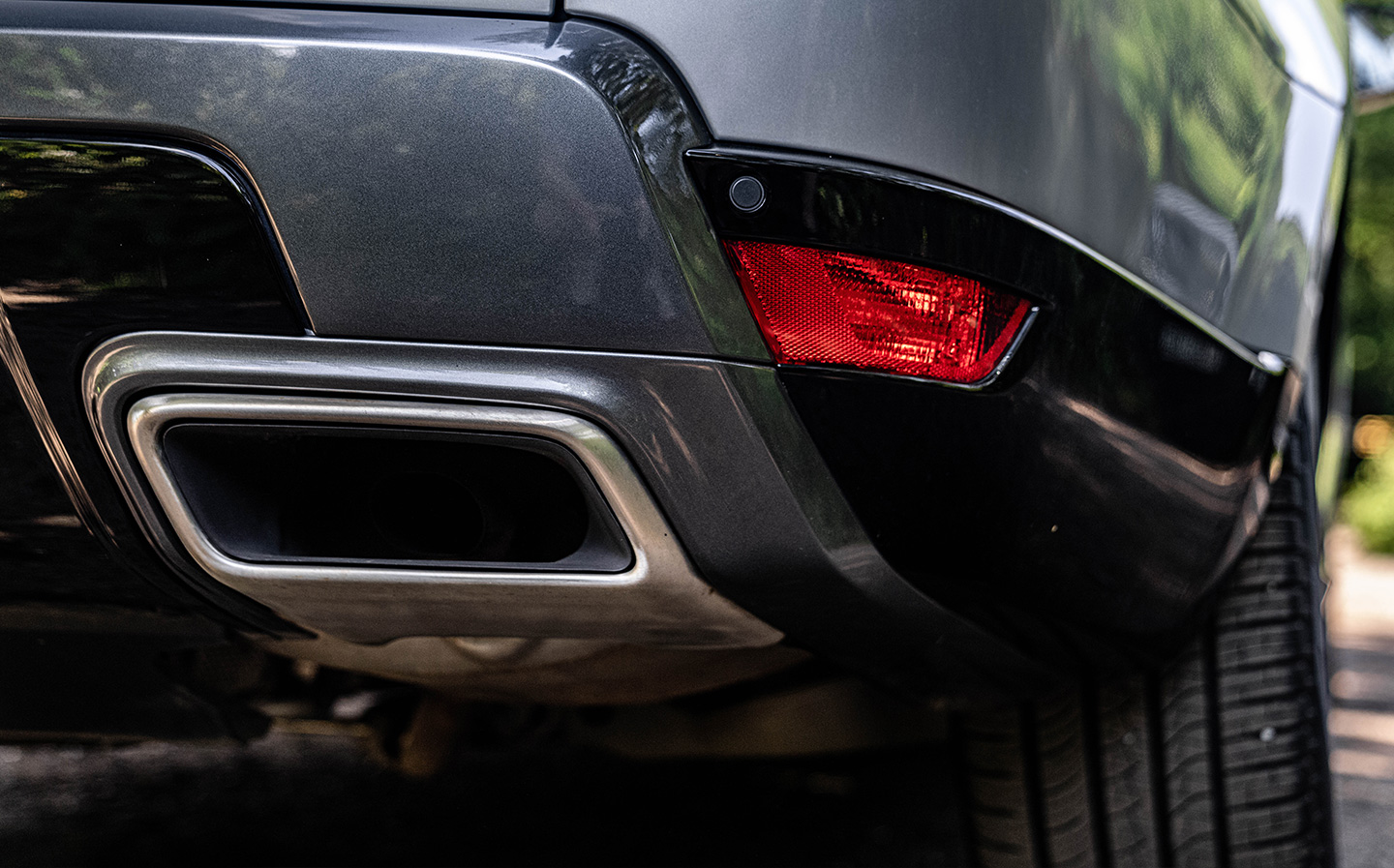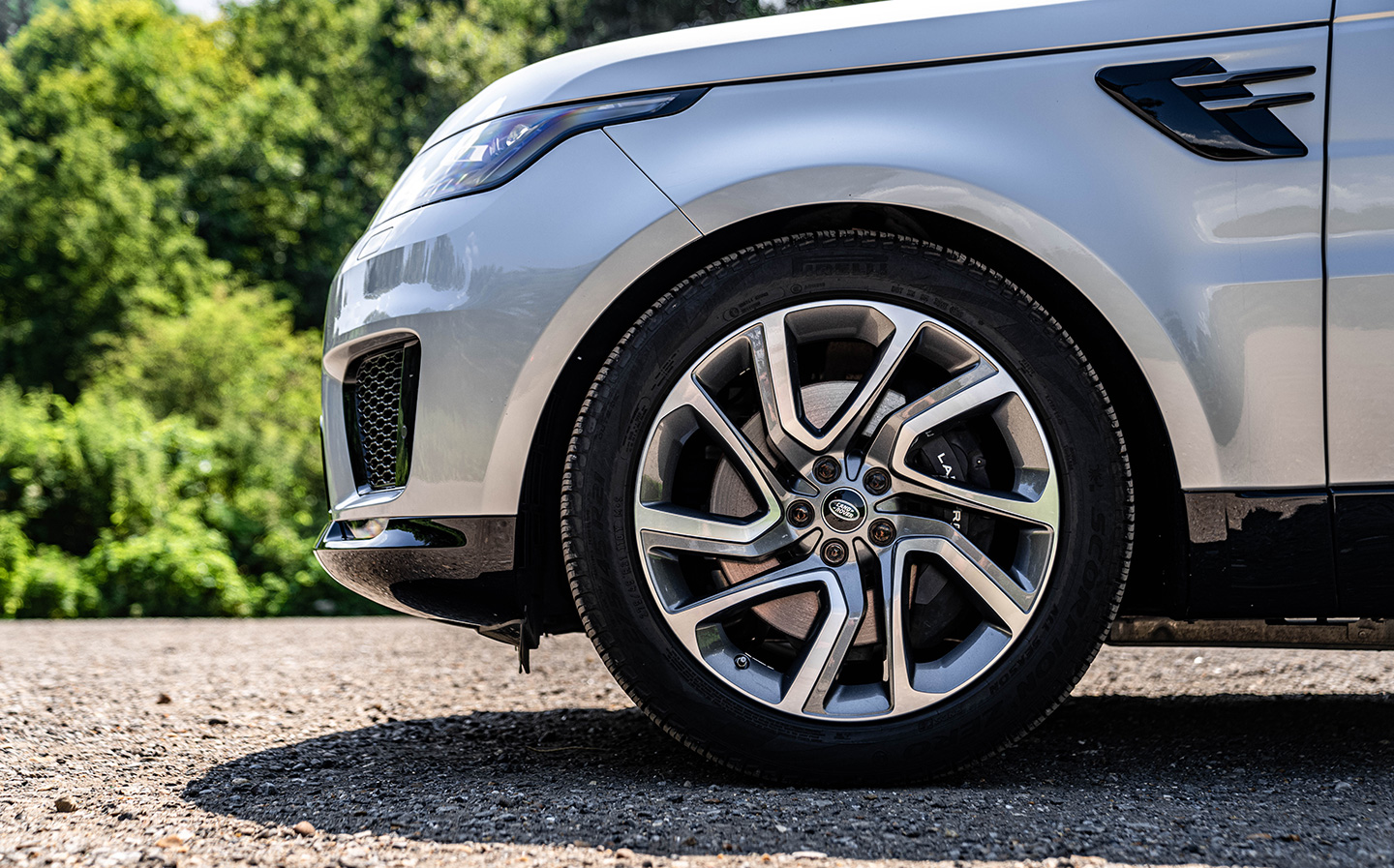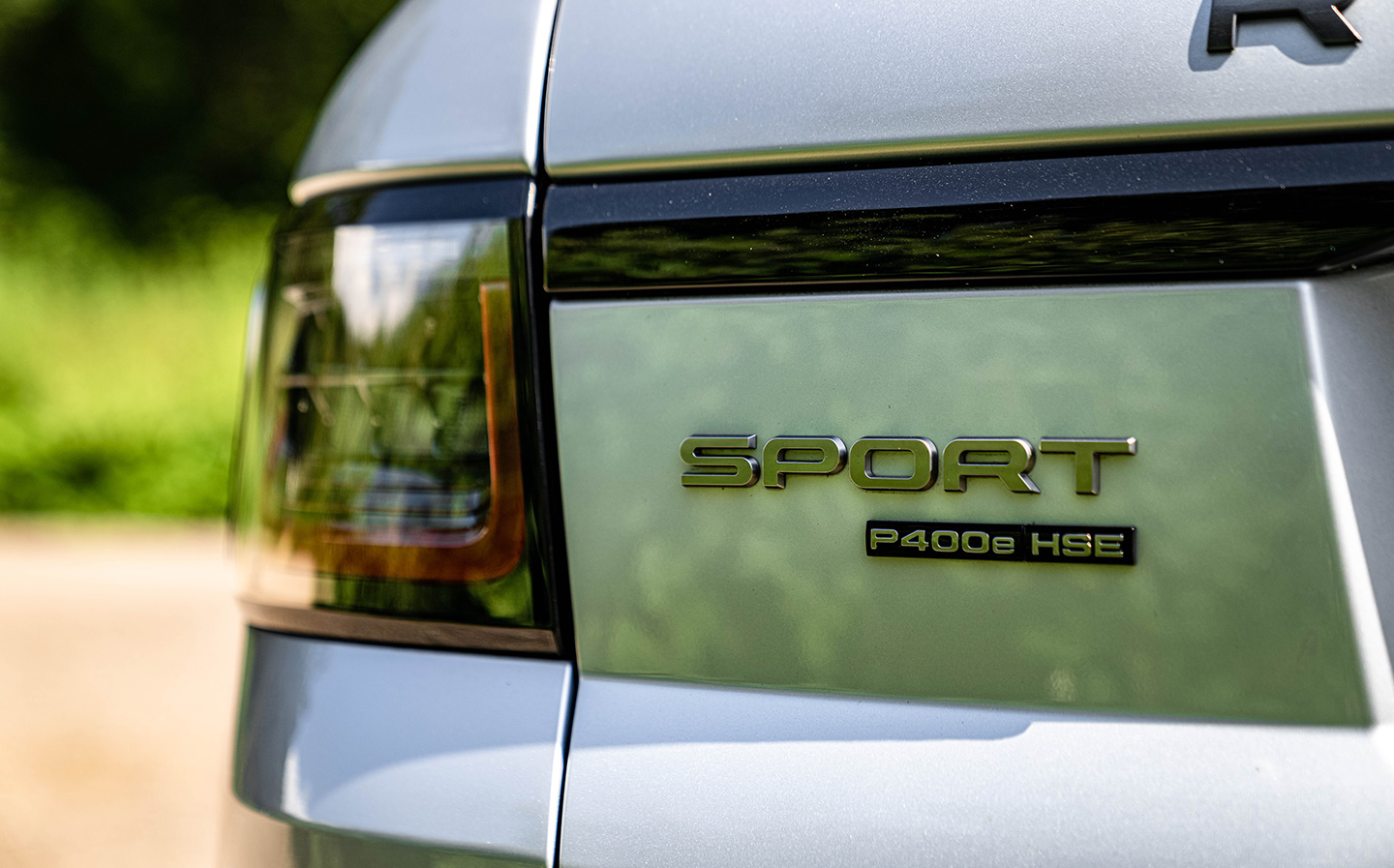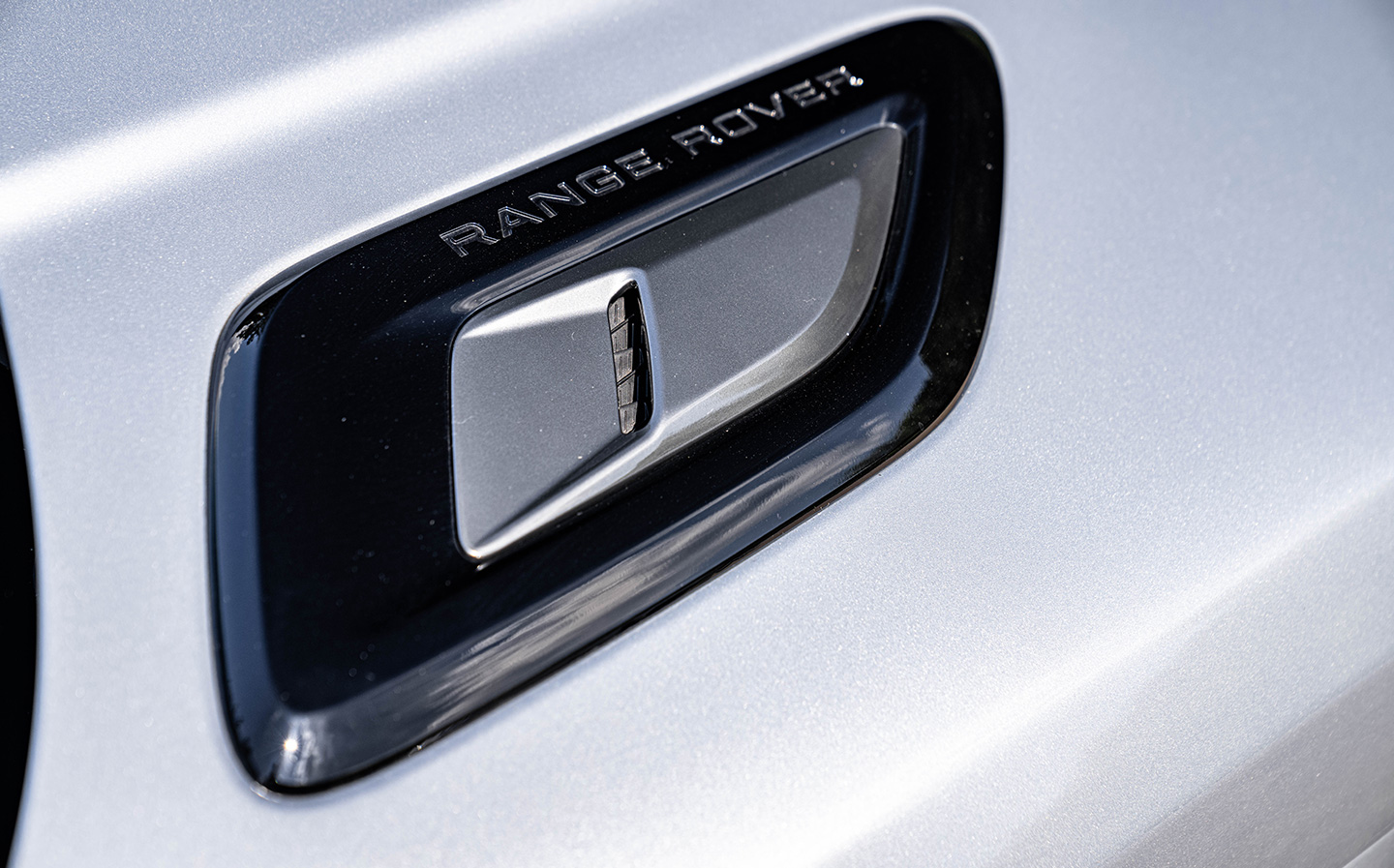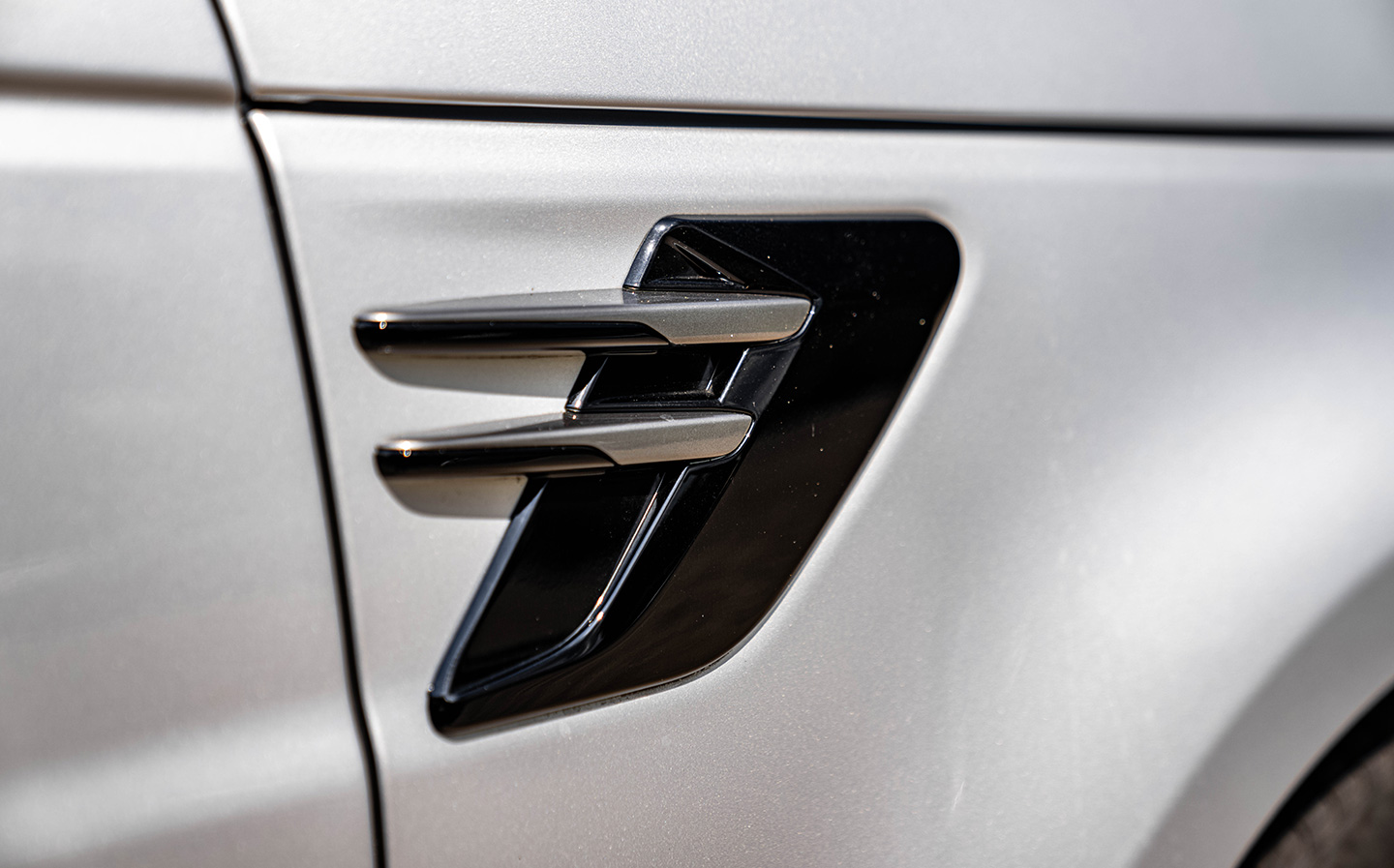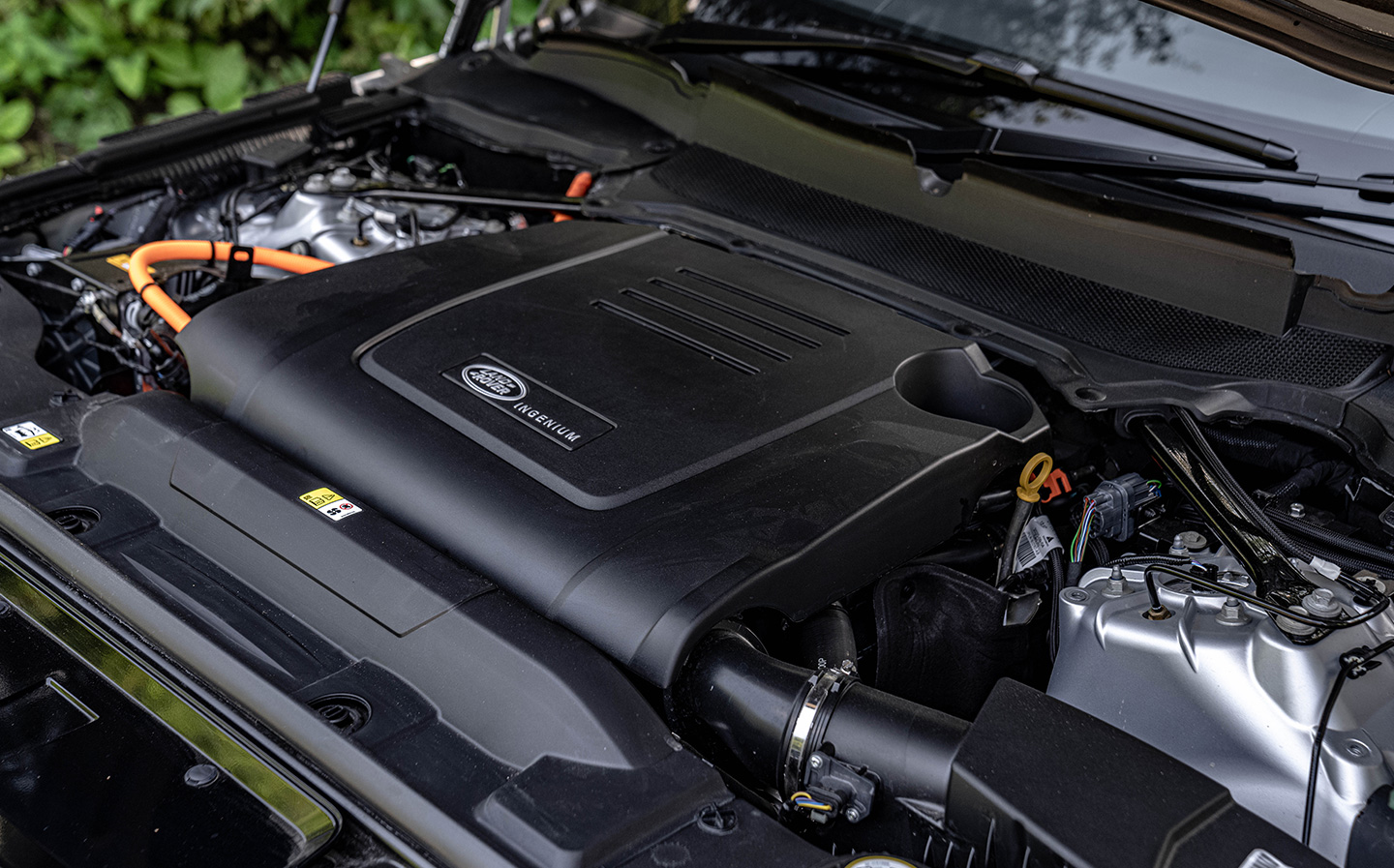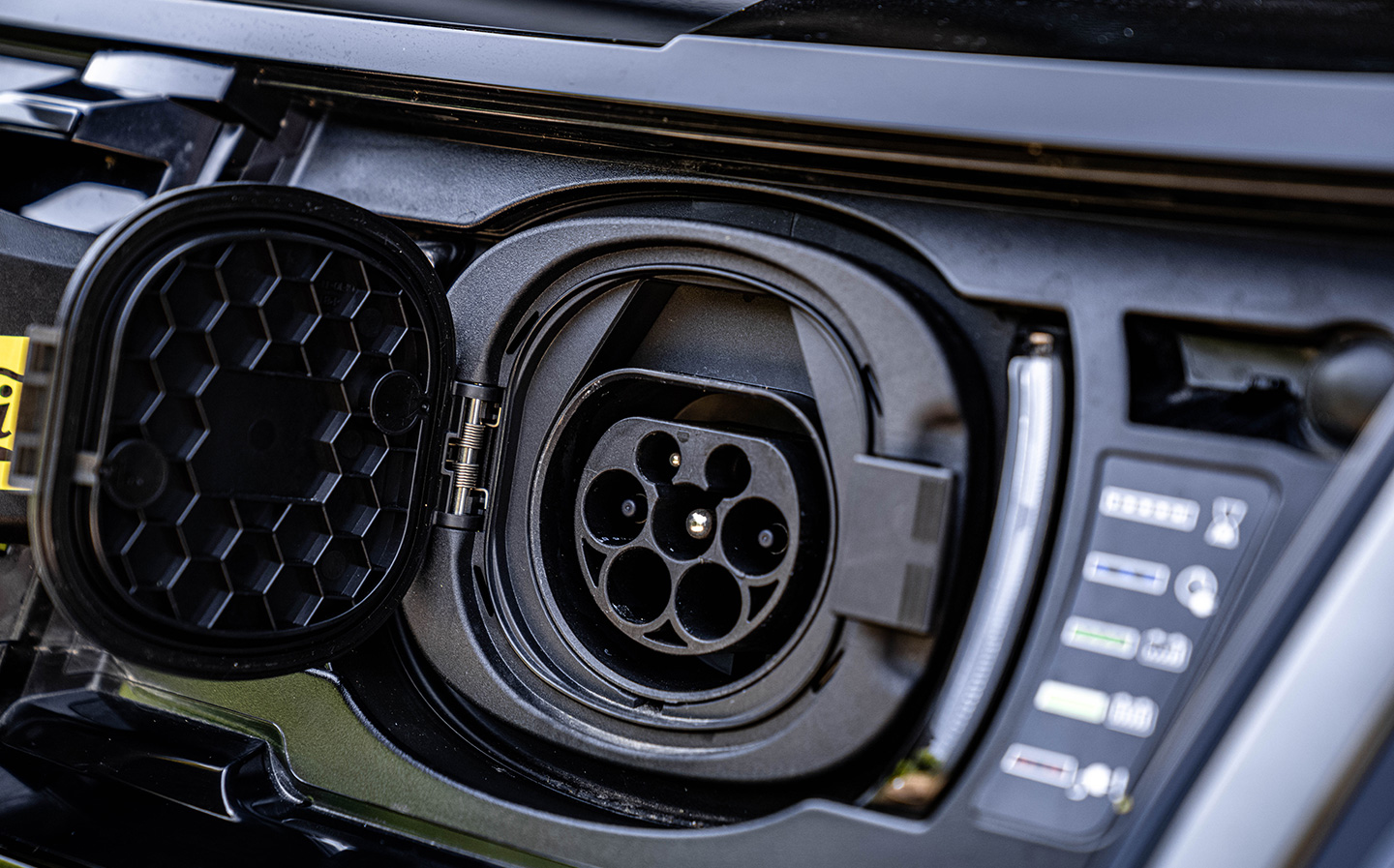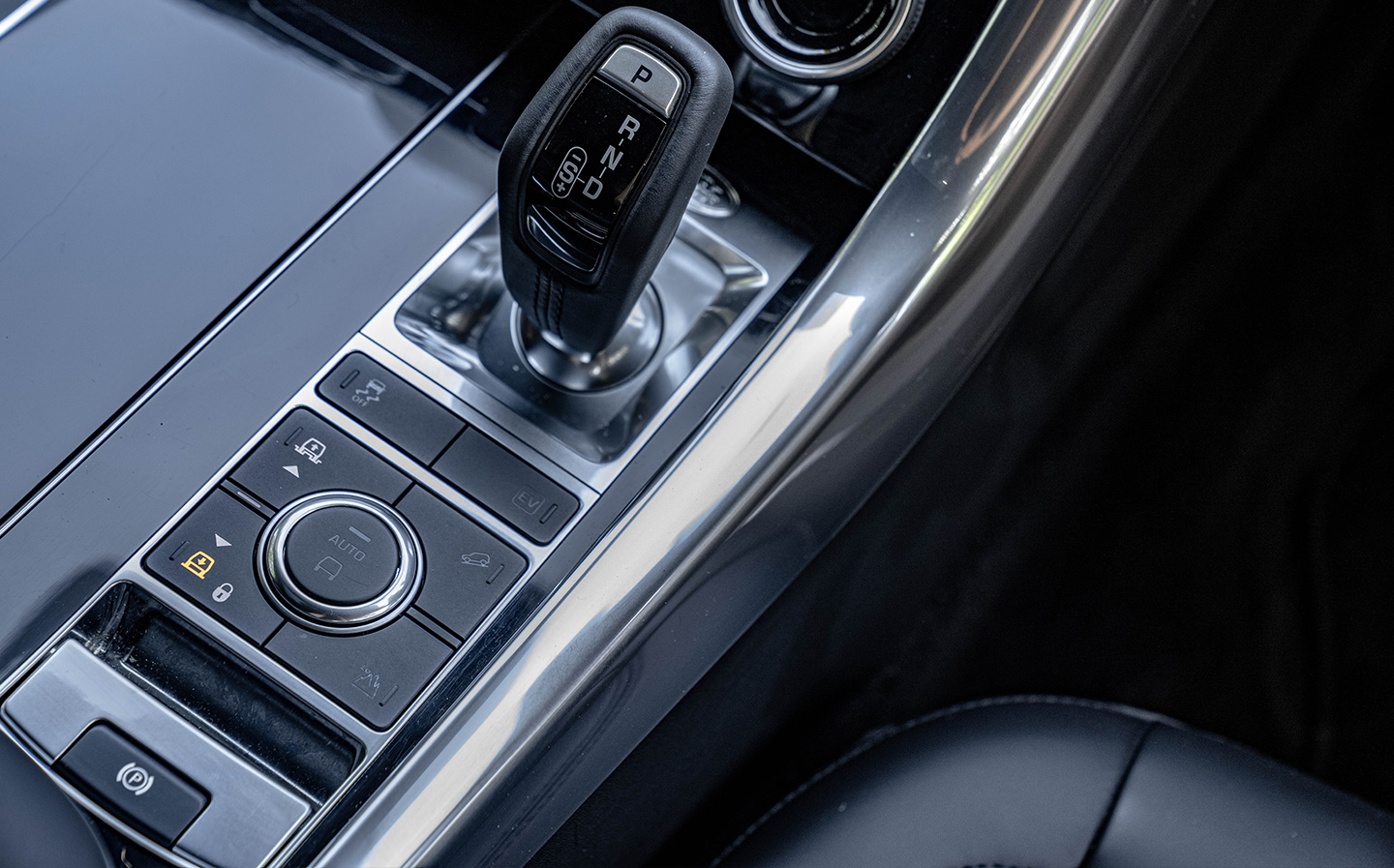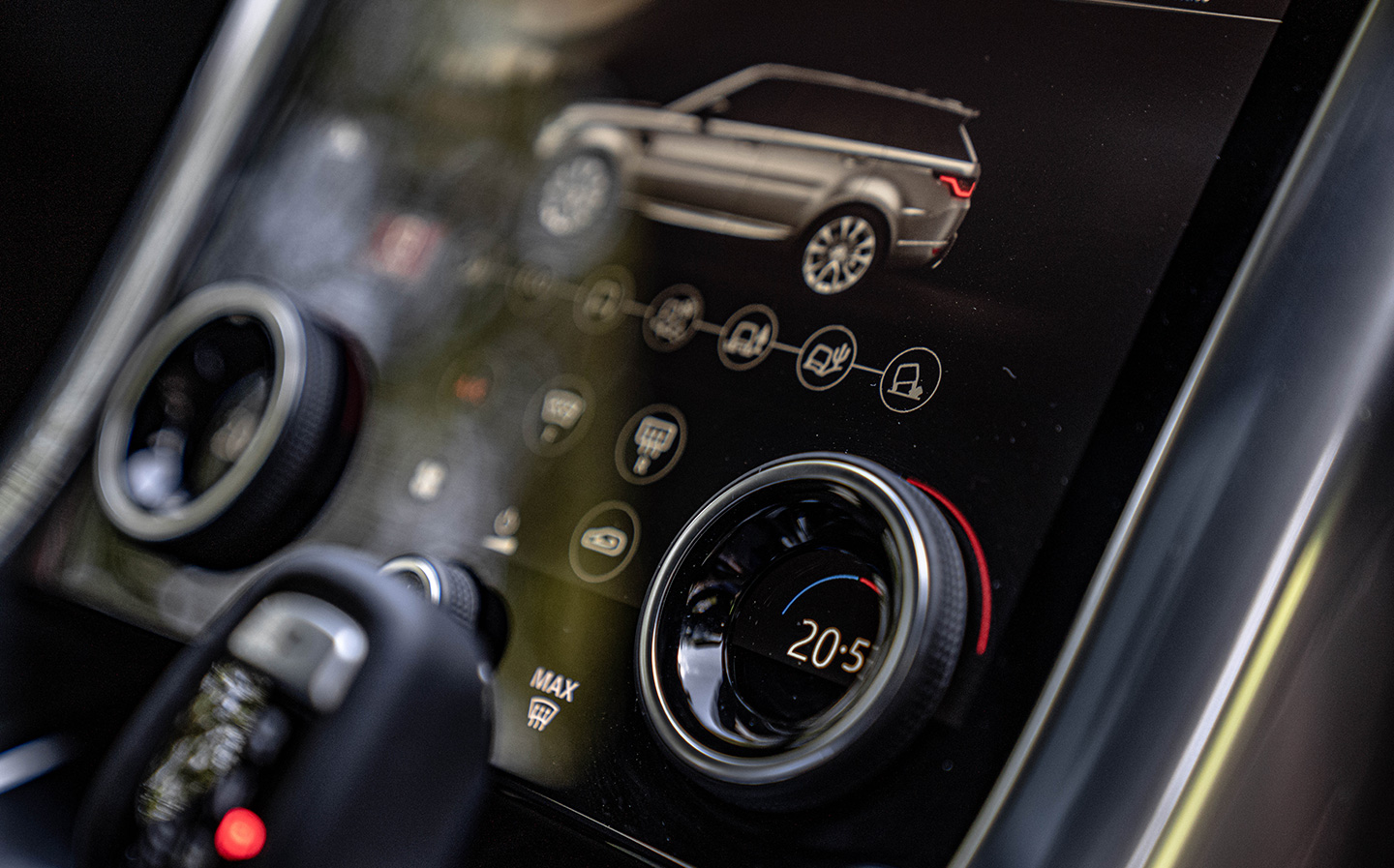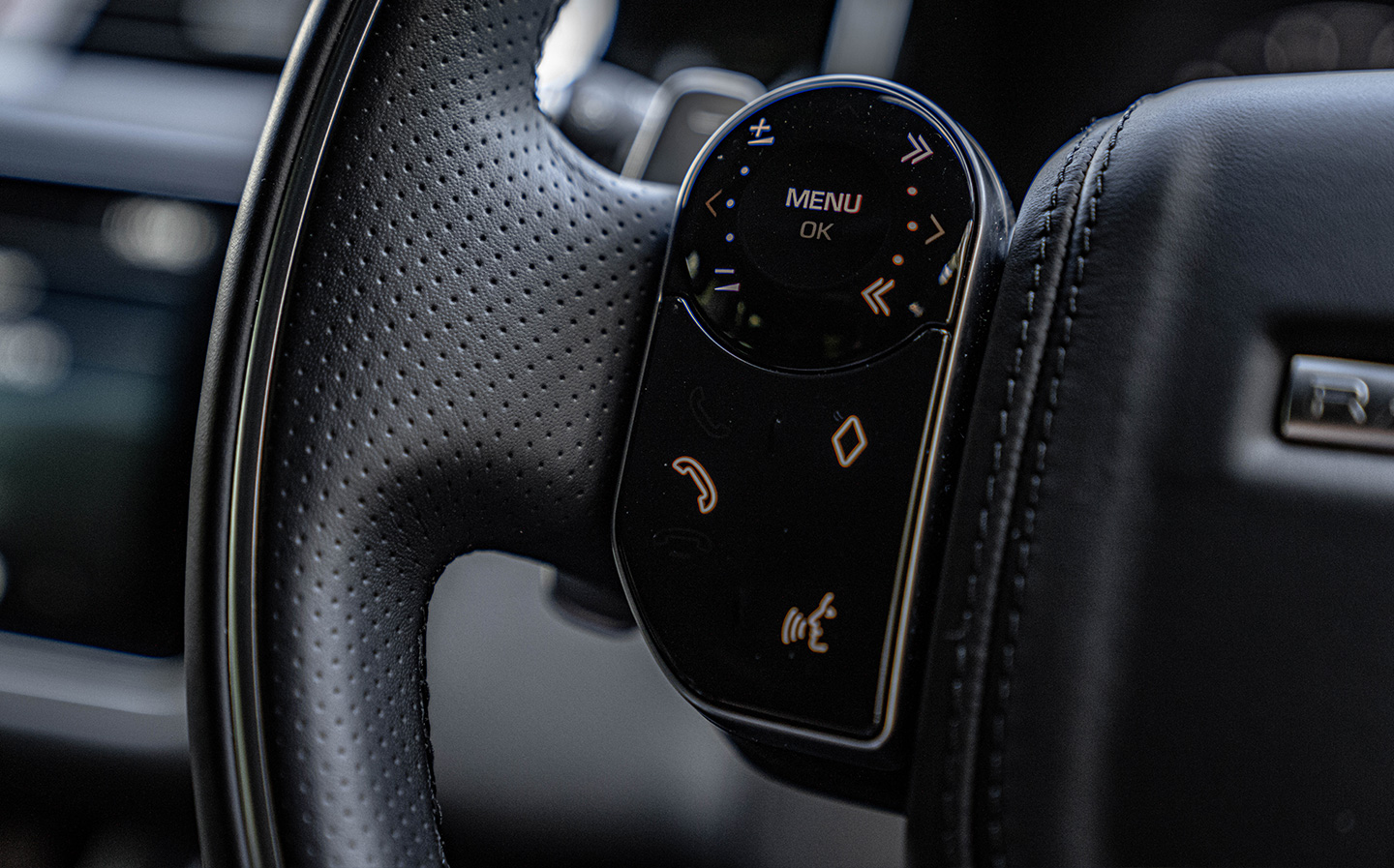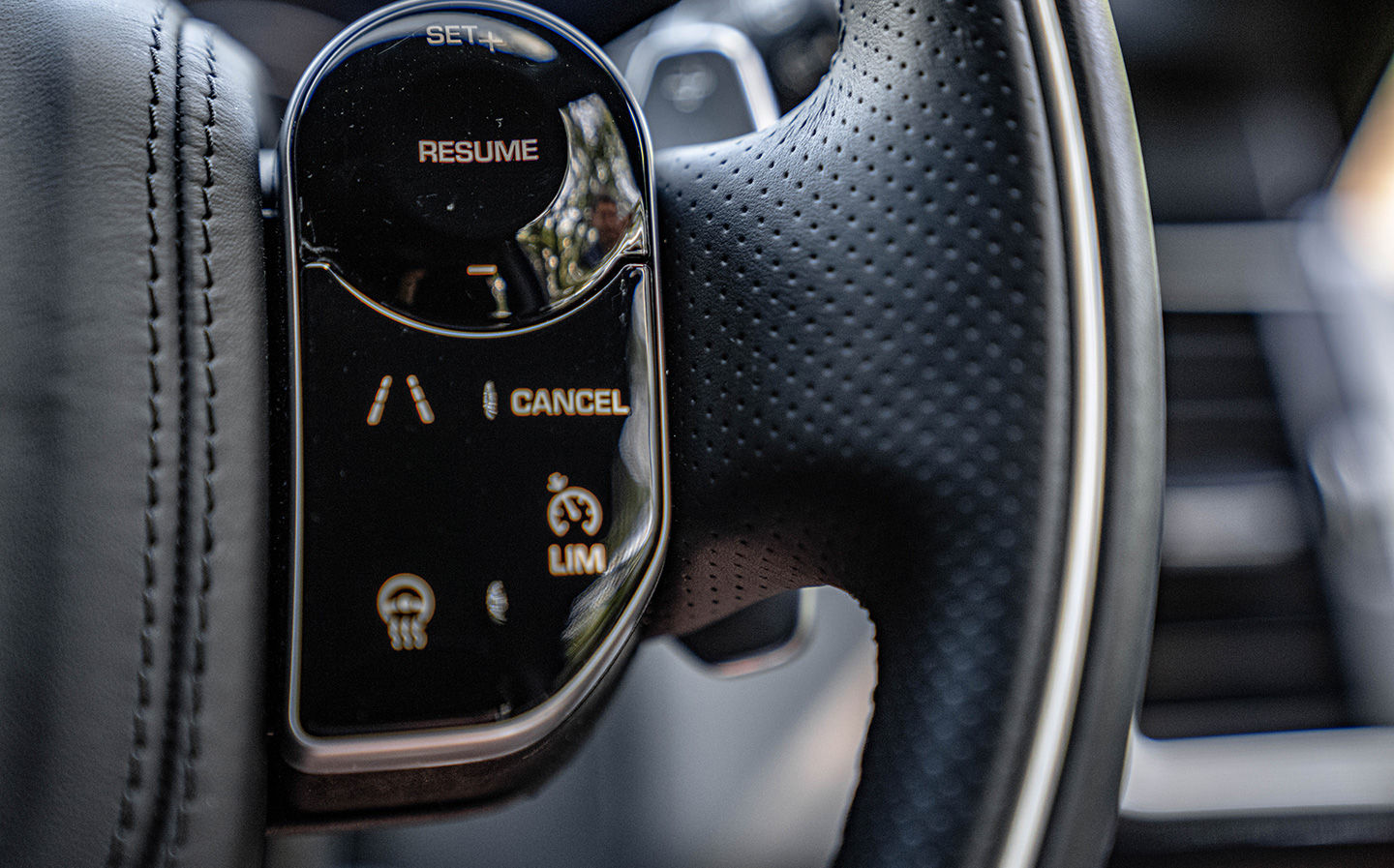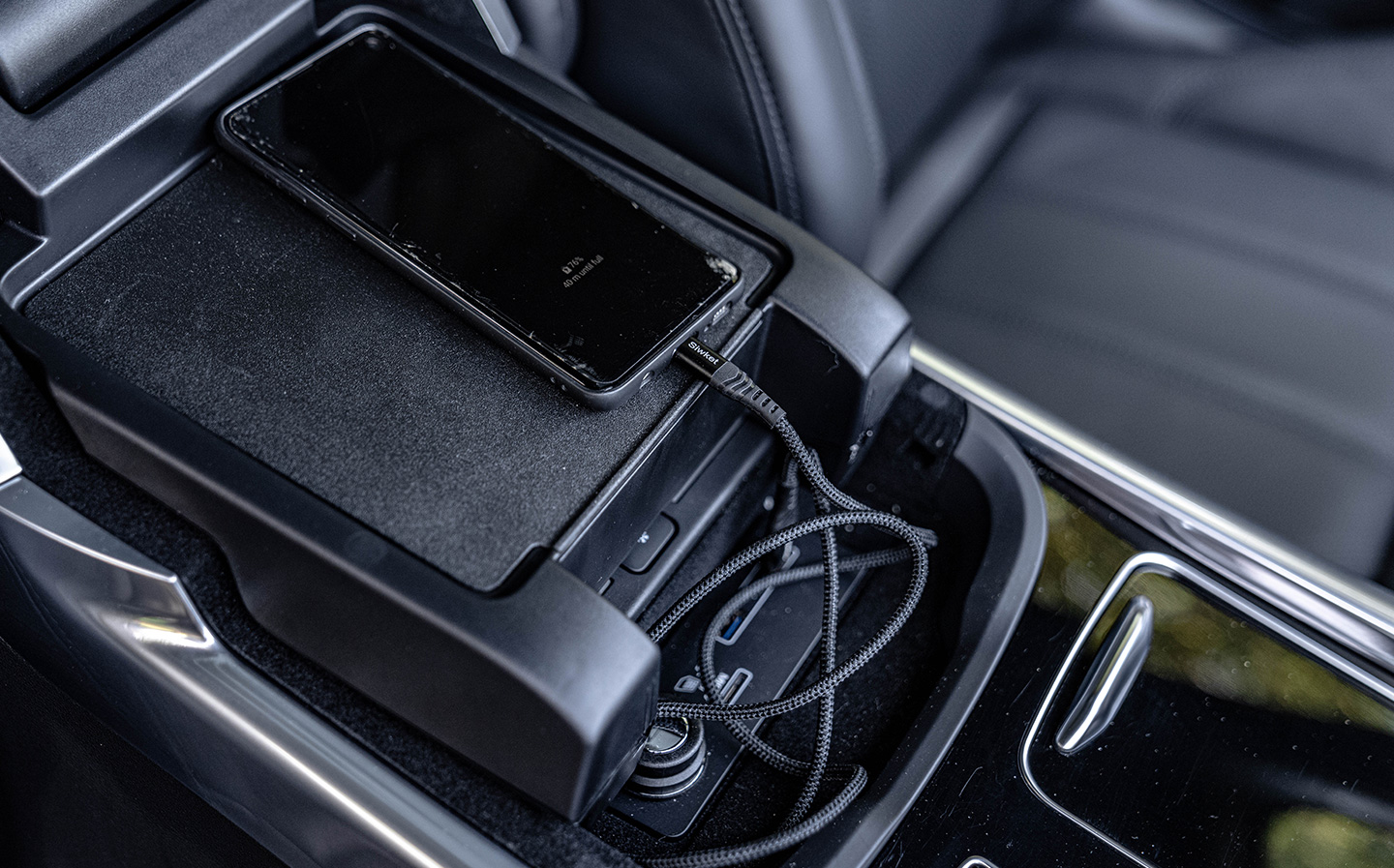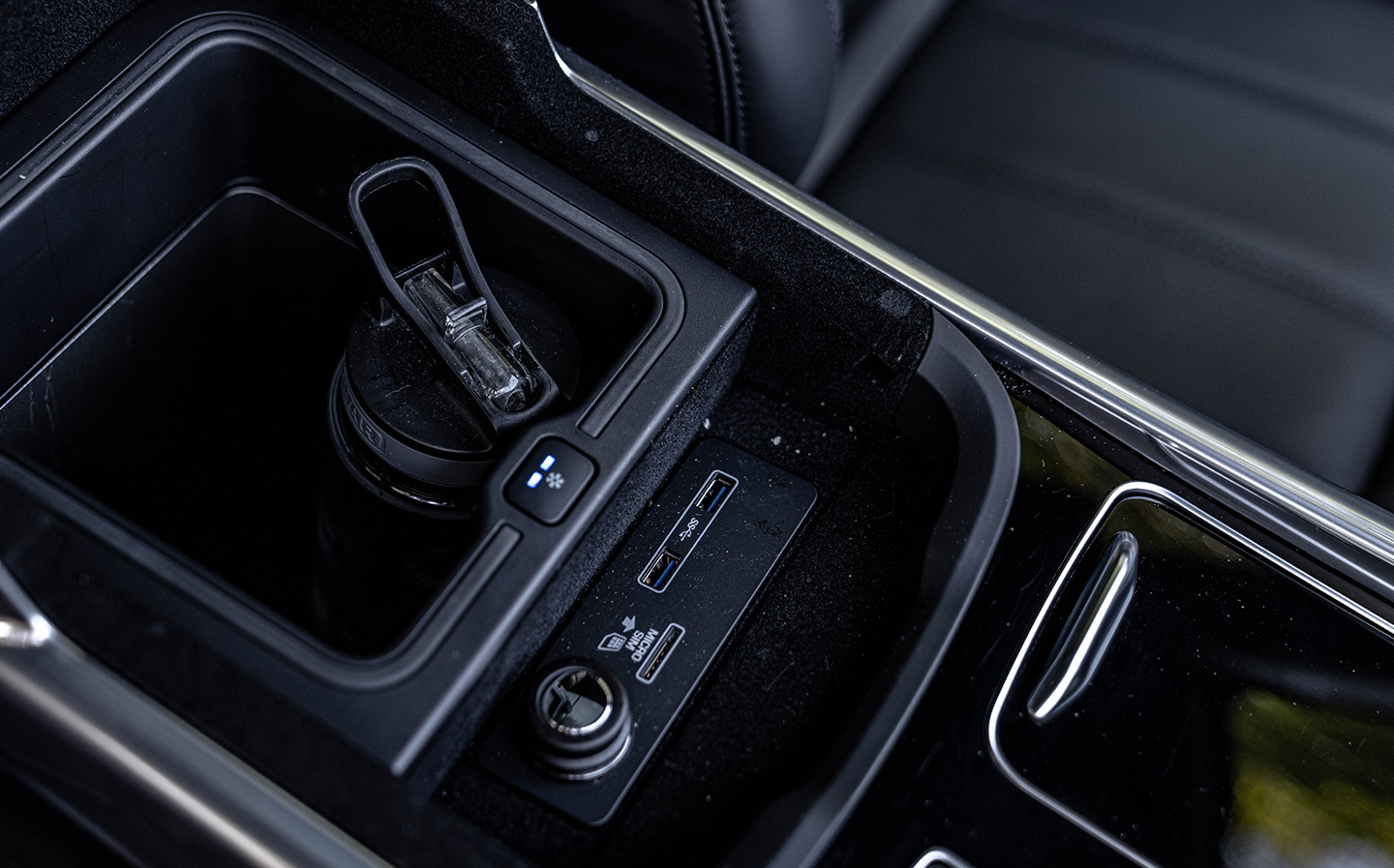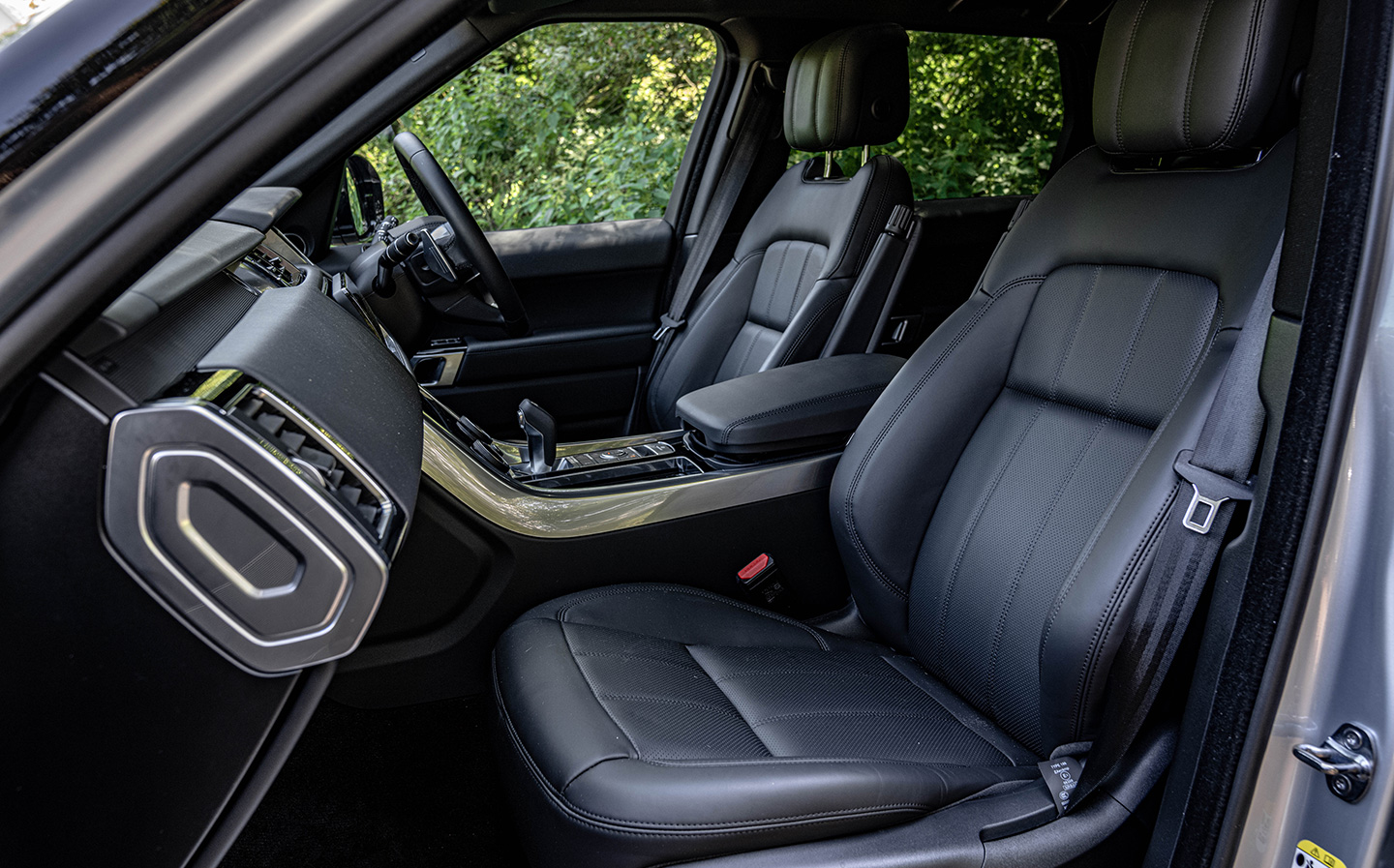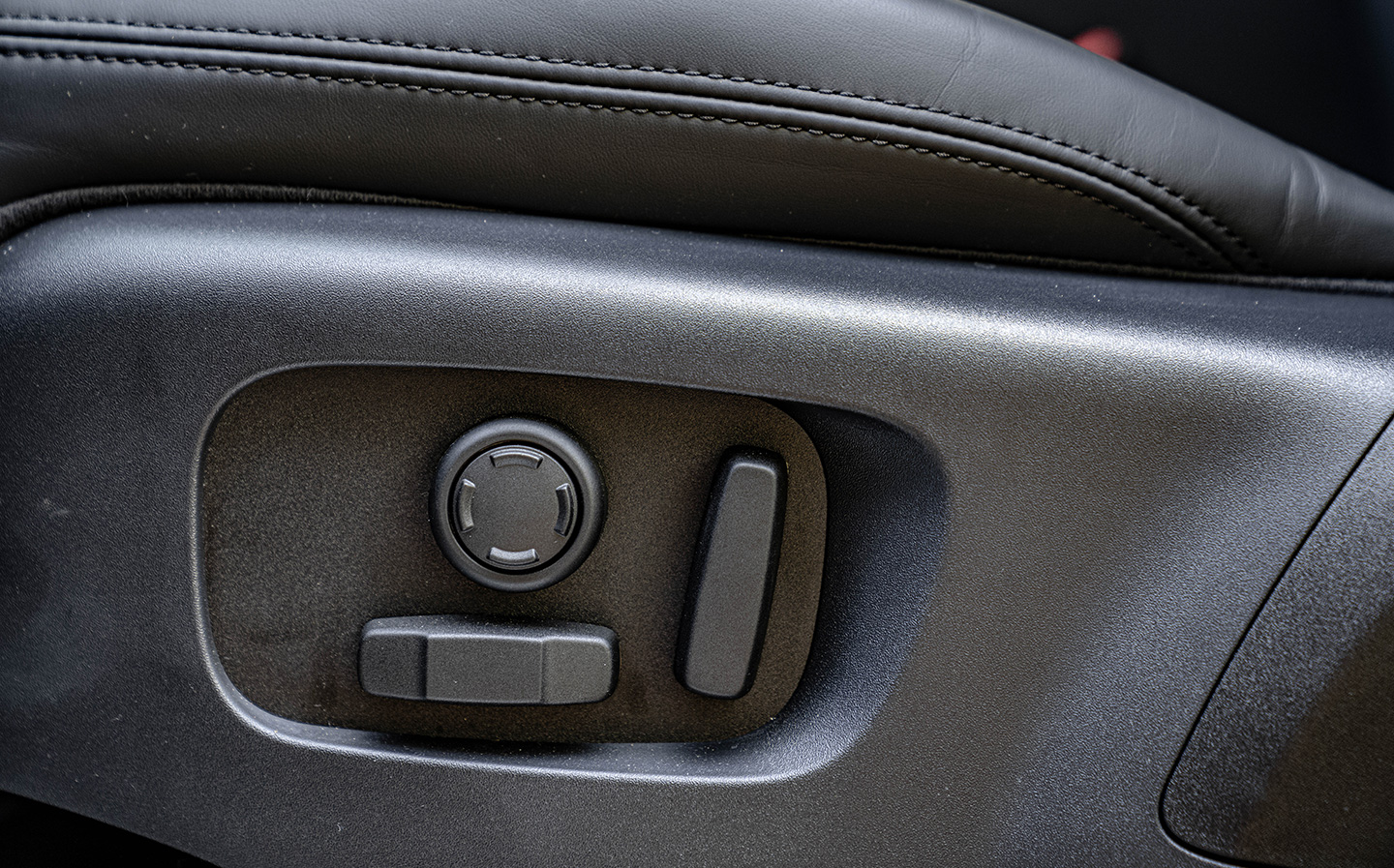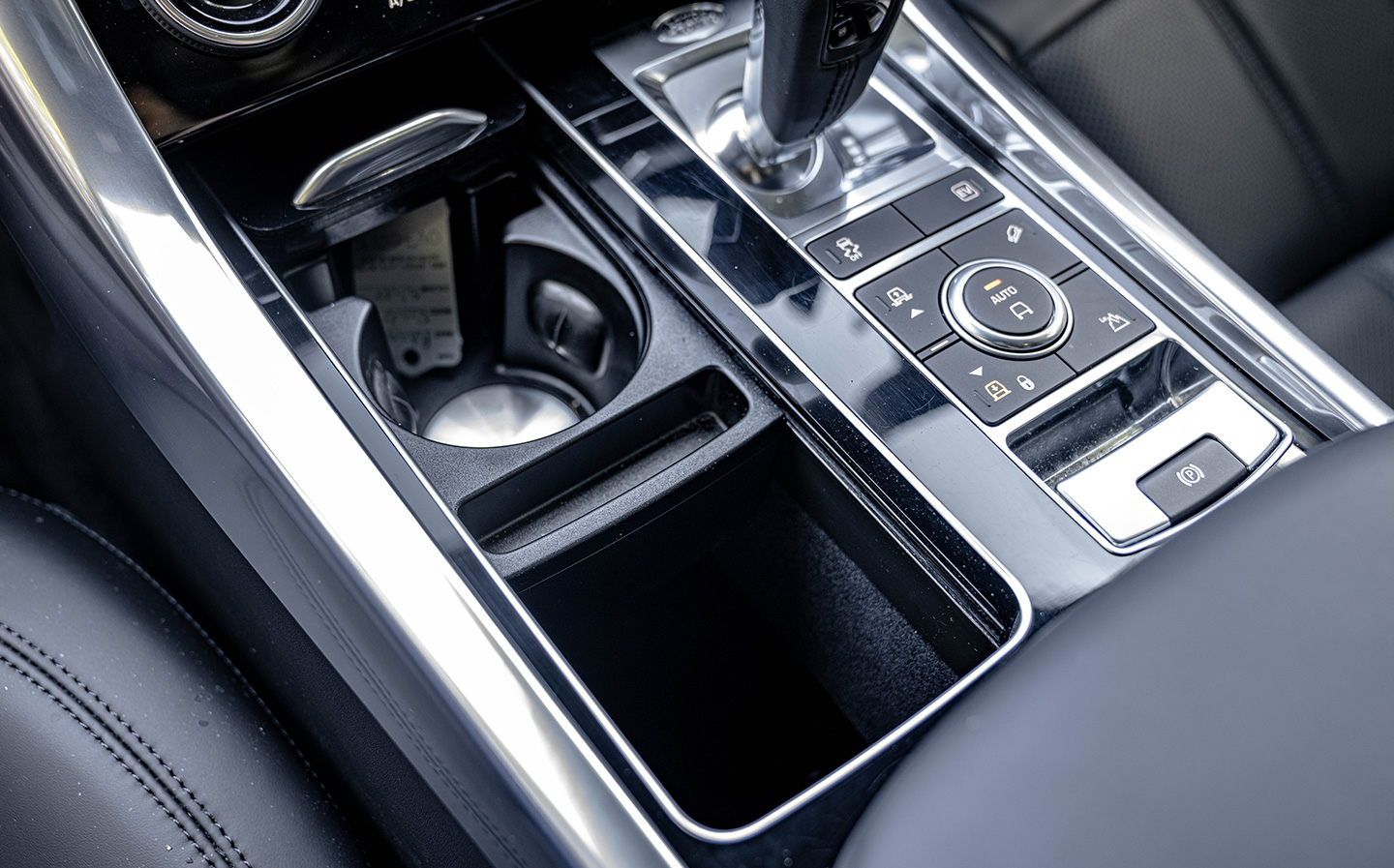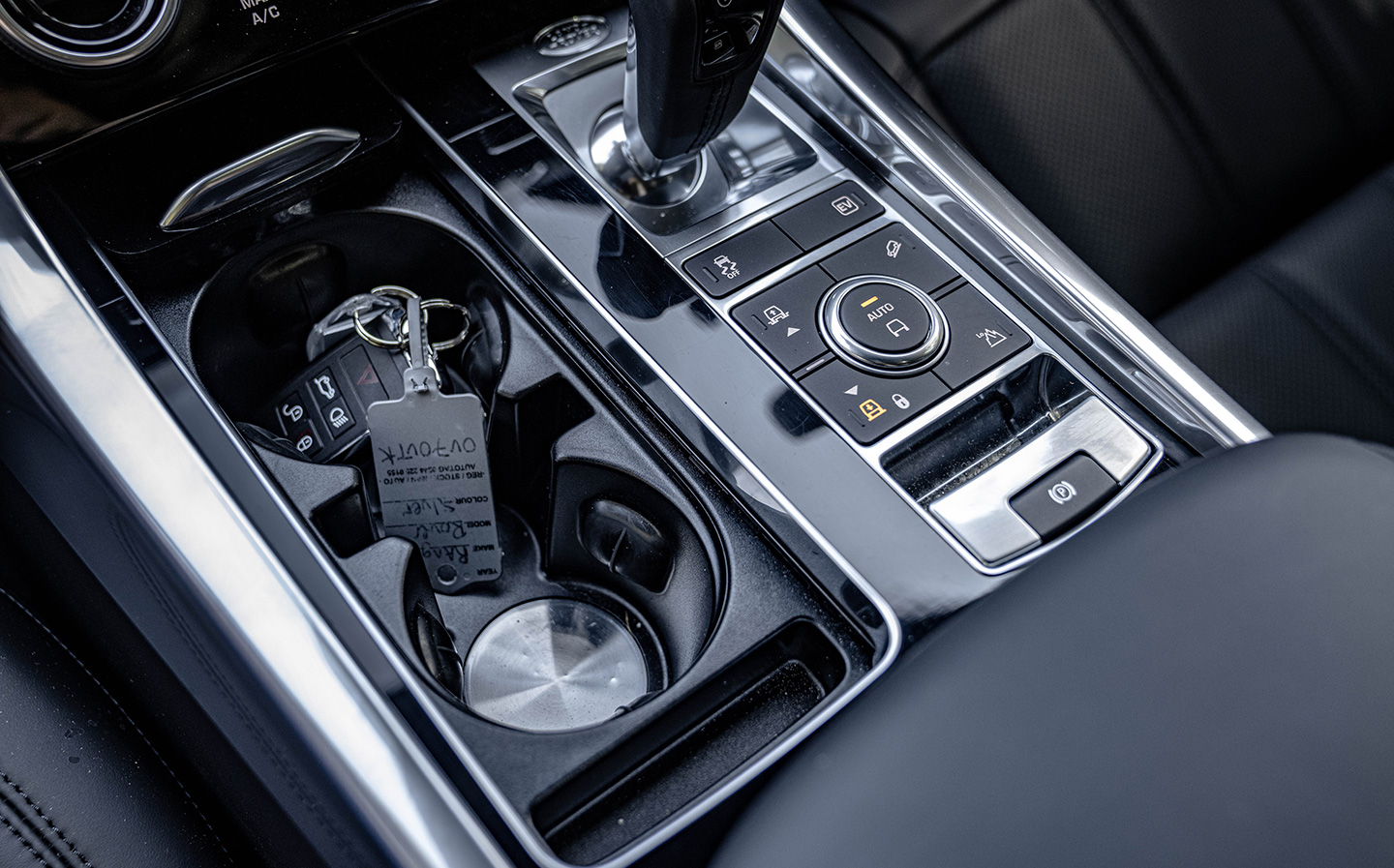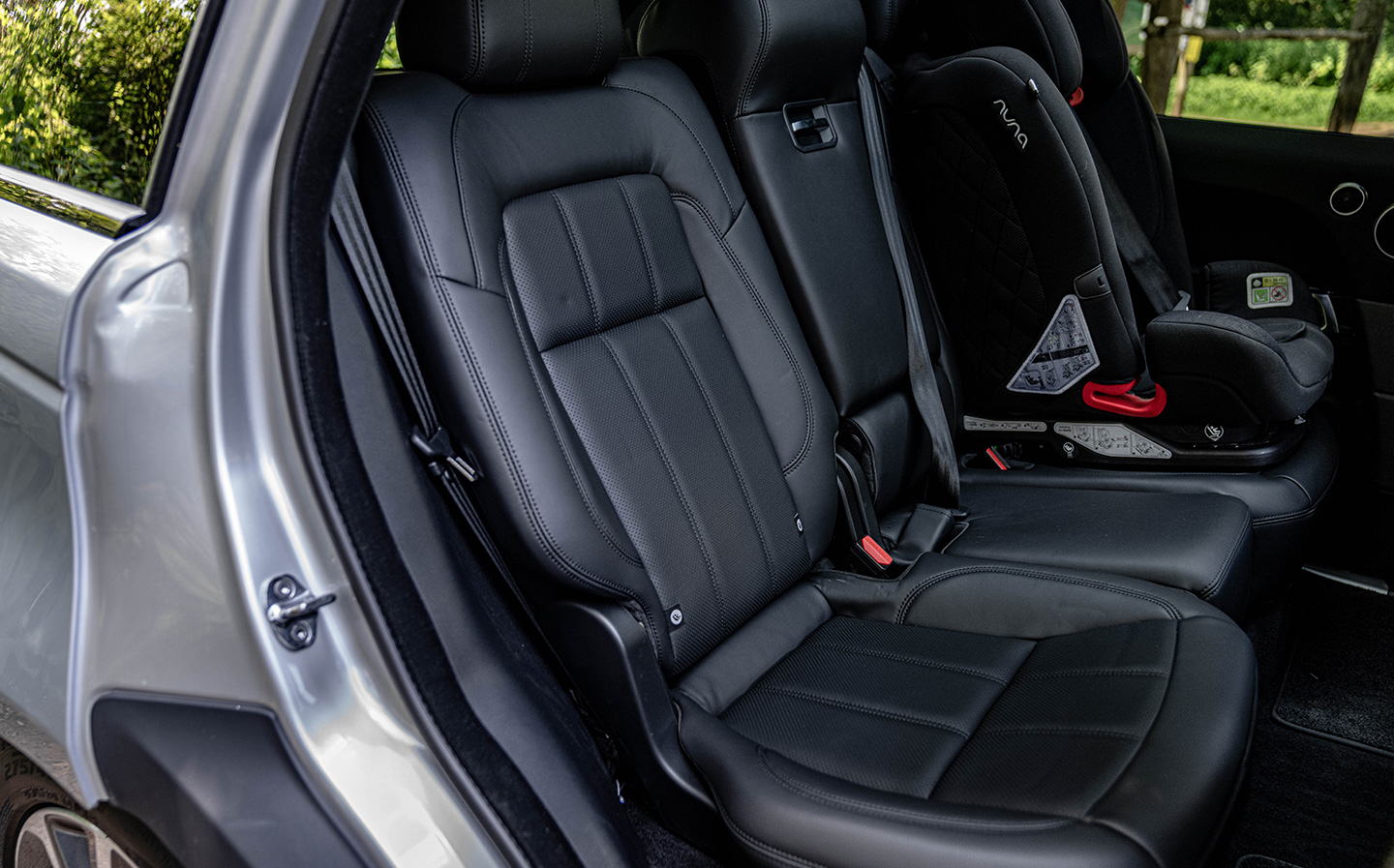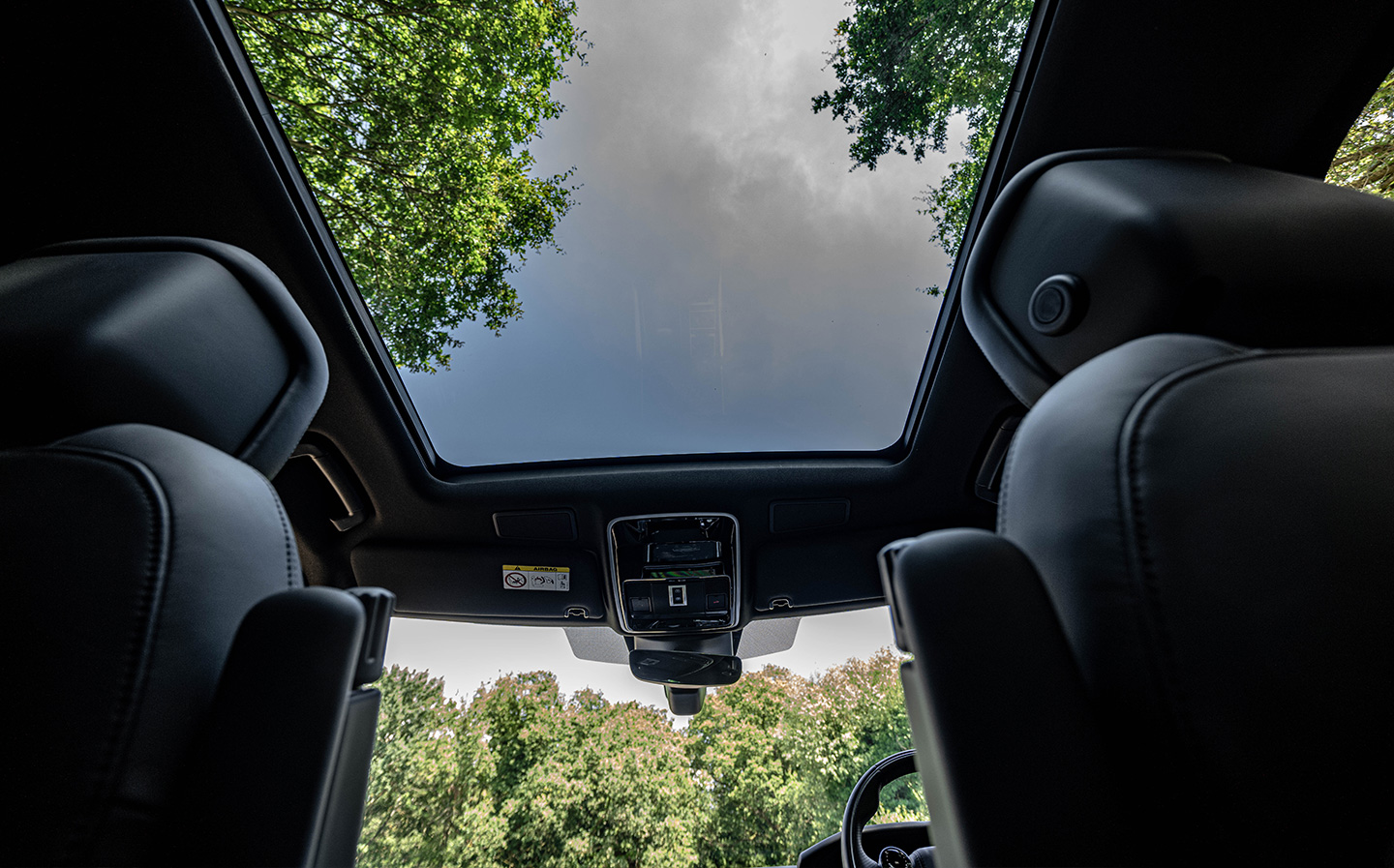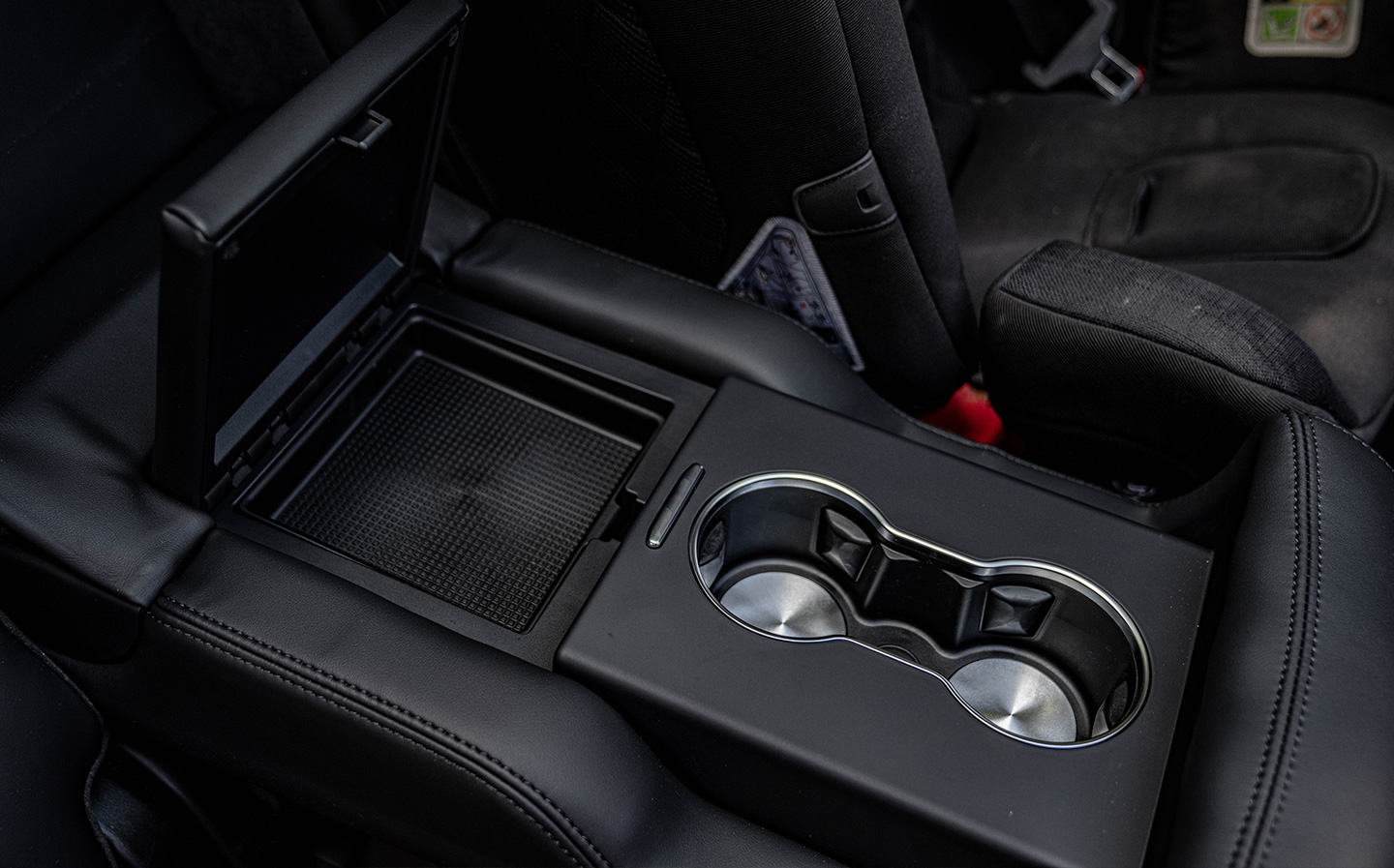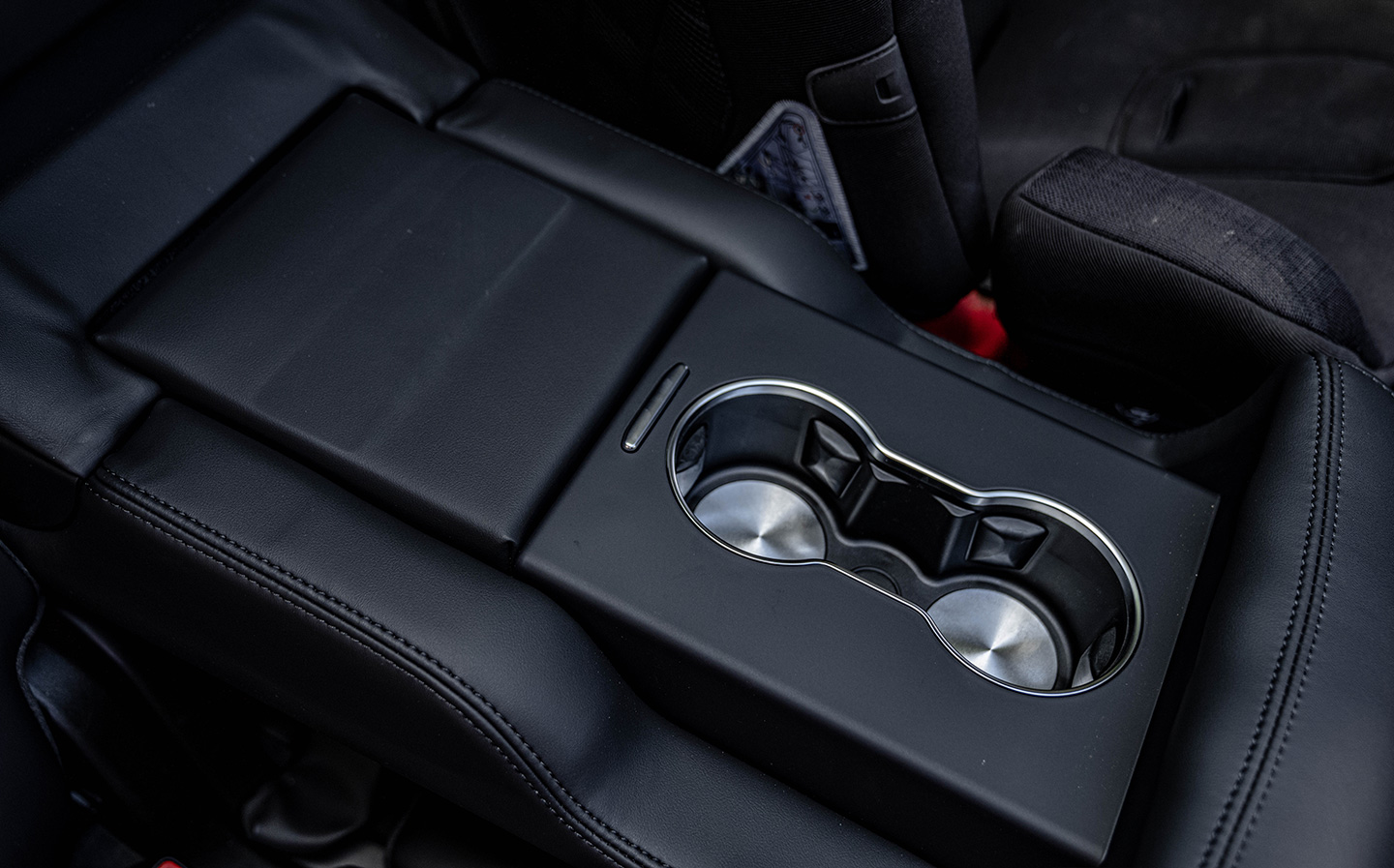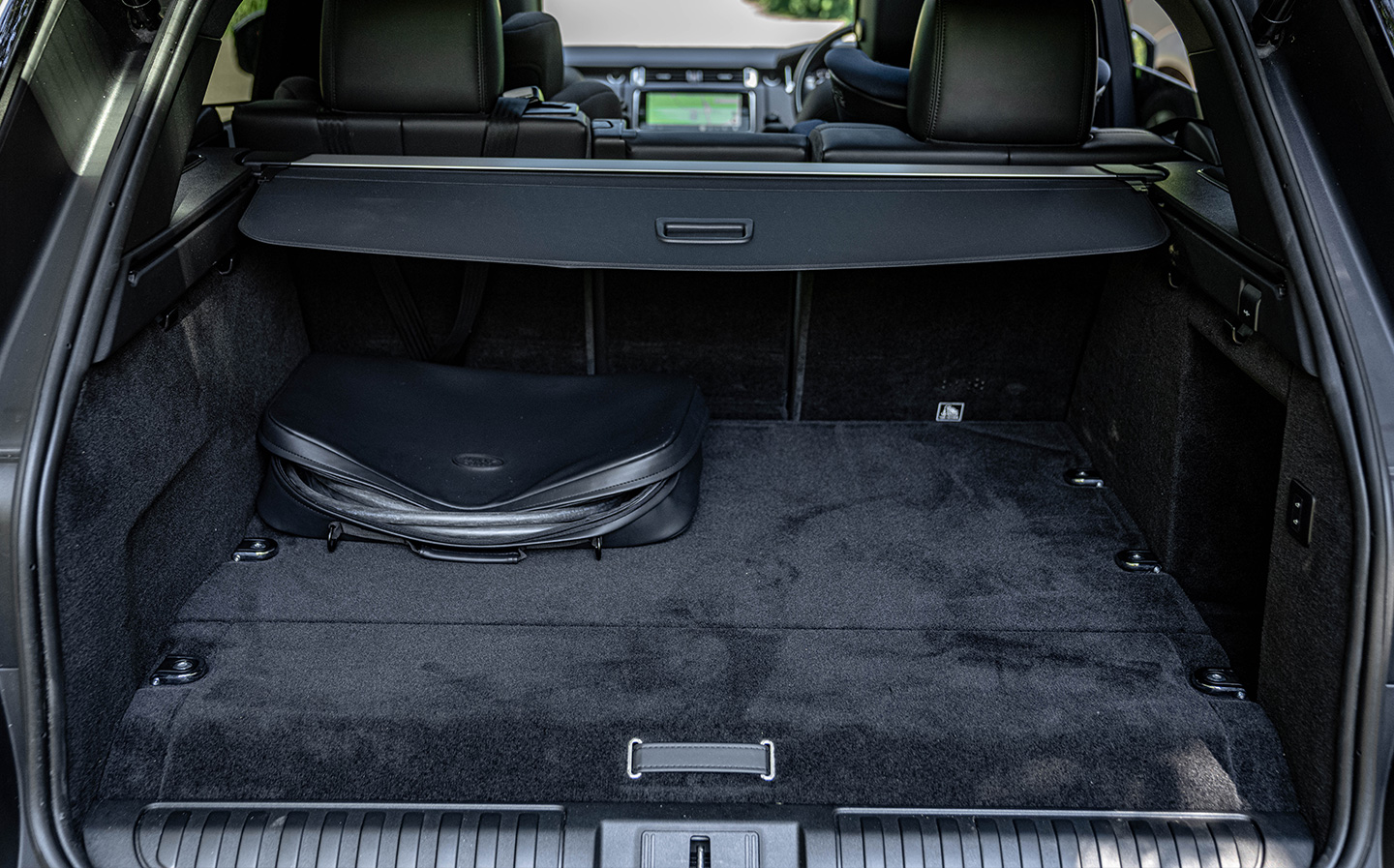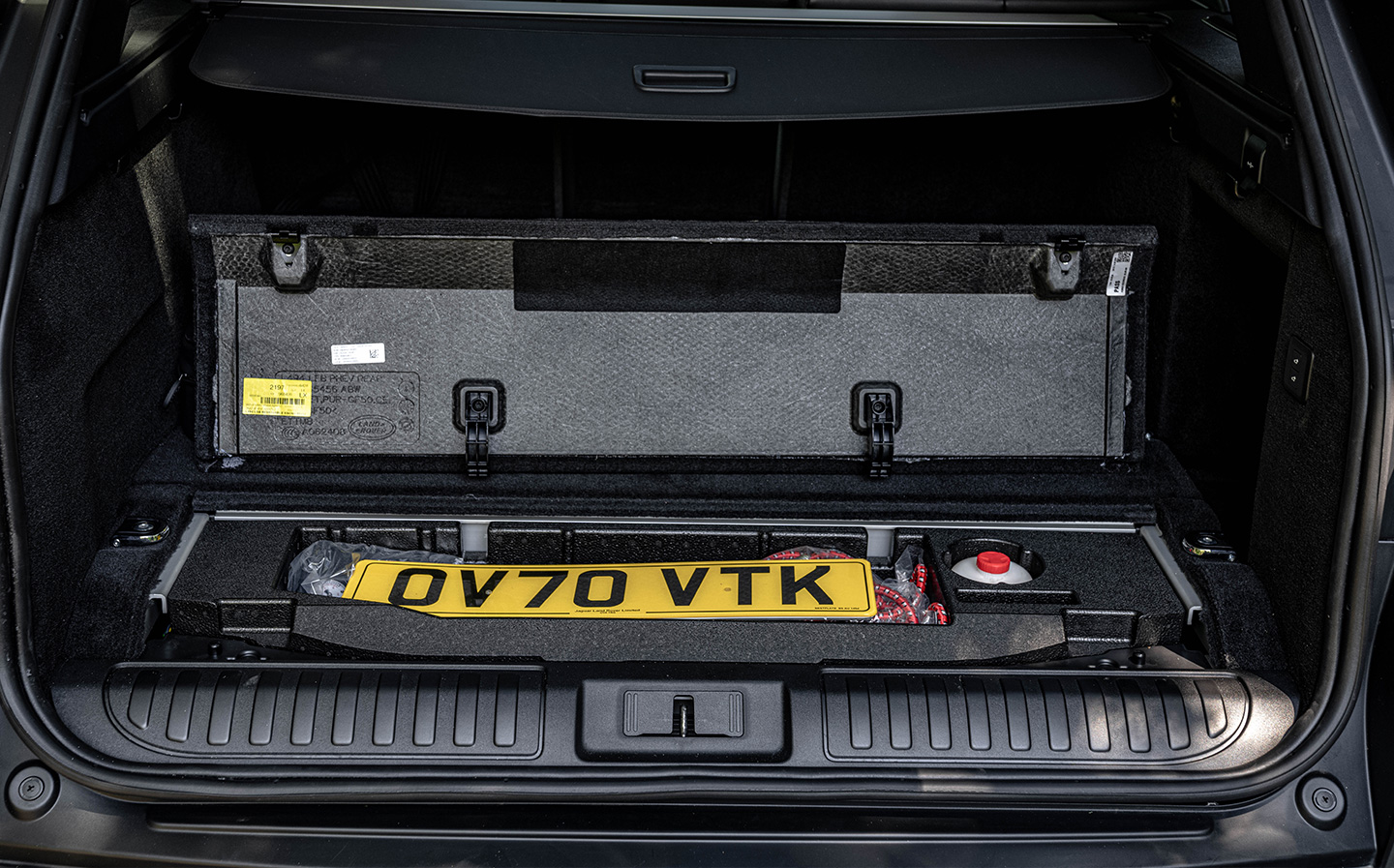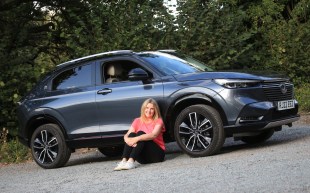Extended Test: 2020 Range Rover Sport PHEV review
Luxurious, sporty, rugged and economical? Can the Range Rover Sport P400e really tick all the boxes?
2020 Range Rover Sport PHEV specifications
- Model 70-reg Range Rover Sport P400e HSE Silver
- Price £75,580 OTR
- Price as tested (with options) £78,035 OTR
- Cost options fitted Hakuba Silver Metallic Paint – £895; Ebony Interior – no cost option; Ebony Morzine Headlining – £330; Three Zone Climate Control – £490; Heated, electric, power fold, memory door mirrors with approach lights; and auto-dimming driver side – £220; Drive Pack – Consists of: Blind Spot Monitor, Driver Condition Monitor, and Traffic Sign Recognition and Adaptive Speed Limiter – £520
- Drivetrain 293bhp, 1,997cc, 4-cylinder petrol engine plus 141bhp electric drive motor and 13.1kWh li-ion battery
- Transmission 8-speed automatic, permanent all-wheel drive
- Power output 398bhp @ 5,500rpm (maximum combined)
- Torque 472 lb ft @ 1,500-4,000rpm (maximum combined)
- Kerb weight (EU / DIN) 2,539kg / 2,464kg
- Max trailer weight (braked / unbraked) 2,500kg / 750kg
- Off road details Ground clearance 278mm; approach angle 33°; departure angle 30°; ramp angle 25.7°
- Boot capacity (rear seats in place / folded) 573 litres / 1,413 litres
- Top speed 137mph
- Acceleration 0-62mph: 6.3sec
- Electric range (WLTP) 31 miles (25 miles EAER)
- Official consumption (WLTP) 73.0-88.3mpg combined
- CO2 emissions 72-87g/km combined
- Charging time (0-100%) 2 hours 45 minutes using 32amp wallbox; 7 hours 30 minutes using the 10 amp home charging cable supplied as standard
- Road tax £0 for first year; £140 thereafter
- BIK tax payable (2021/22) 7%; £470 (20%) or £939 (40%)
- Insurance group 21
Test details
Test period July – December 2021
Starting mileage 3,598 miles
Test updates
- August 13, 2021 Introducing the Range Rover Sport P400e
- September 6, 2021 Road trip: how does the RR Sport fare on a family holiday?
- November 8, 2021 How economical is the Range Rover Sport P400e, and how easy is it to recharge?
- January 5, 2022 What spec and options for the Range Rover Sport?
- January 29, 2022 Oh, bugger: An off-roading high followed by reliability low (final report)
August 13: Introducing the Range Rover Sport P400e
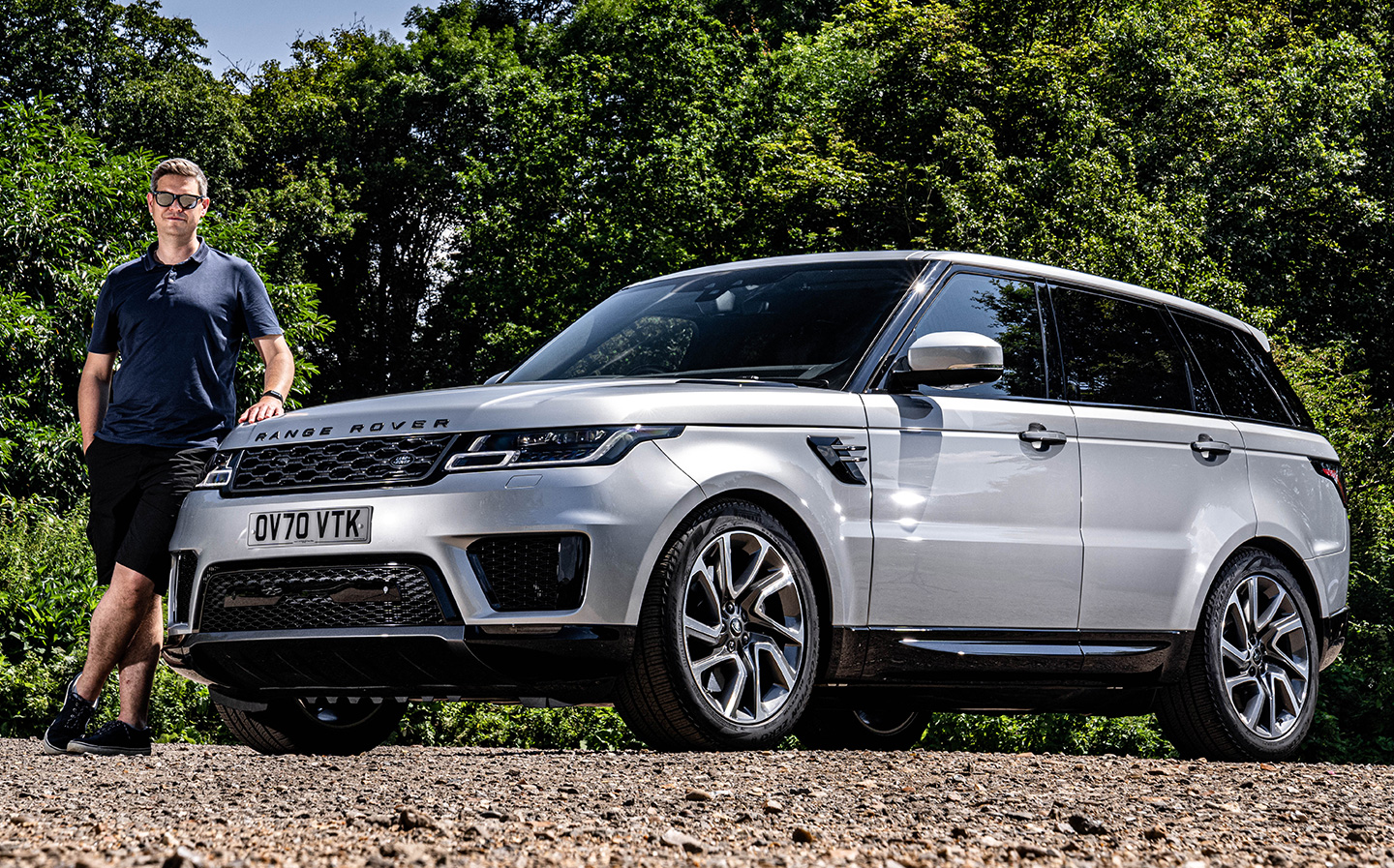
When is a big, powerful, luxury 4×4 not a gas guzzler? When it’s a plug-in hybrid — that’s the idea of the Range Rover Sport P400e, anyway.
Despite producing 400bhp from its combination of 2-litre petrol engine and electric motor, it can run on electric mode for 25 miles (officially) so officially its average combined fuel consumption is 73-88mpg, depending on the wheel size. Hmm, we’ll see about that.
The Range Rover Sport is, as the name suggests, the full-fat Range Rover’s more athletic younger sibling. It’s smaller than the Range Rover but, as I realised when I parked next to one, not by much: the Sport’s just 121mm shorter, 66mm lower (in the standard ride height setting) and actually the same width.
It’s fair to say the Range Rover Sport is still a beast, and an imposing presence on the road. But, as I’ll get to in a later update, having recently driven the regular Range Rover, too, the Sport does feel taughter and more responsive on the road. It provides a more entertaining driving experience, rather than all-out comfort.
It’s not exactly a new model — my test car was registered last year and the plug-in hybrid version was first introduced in 2018, when the second-generation Range Rover Sport was refreshed — but as perhaps one of the most advanced and complicated versions of a Land Rover currently on sale, and one I hadn’t tested, I wanted to see how it fared over a full six months.
I’m not saying I’m expecting faults to arise but this particular car maker has, let’s say, a reputation — rightly or wrongly. Should issues occur, I’ll not spare any blushes, and feel free to let me know about your experiences of owning a RR Sport in the comments below.
I could have ordered a shiny new model, of course, and Land Rover recently relaunched its online configurator to allow customers to not only buy online, but also get a full quote for trade-in without having to step foot in a dealership. I’ll explore the configurator in more detail in a later post, when I look at the must-have options.
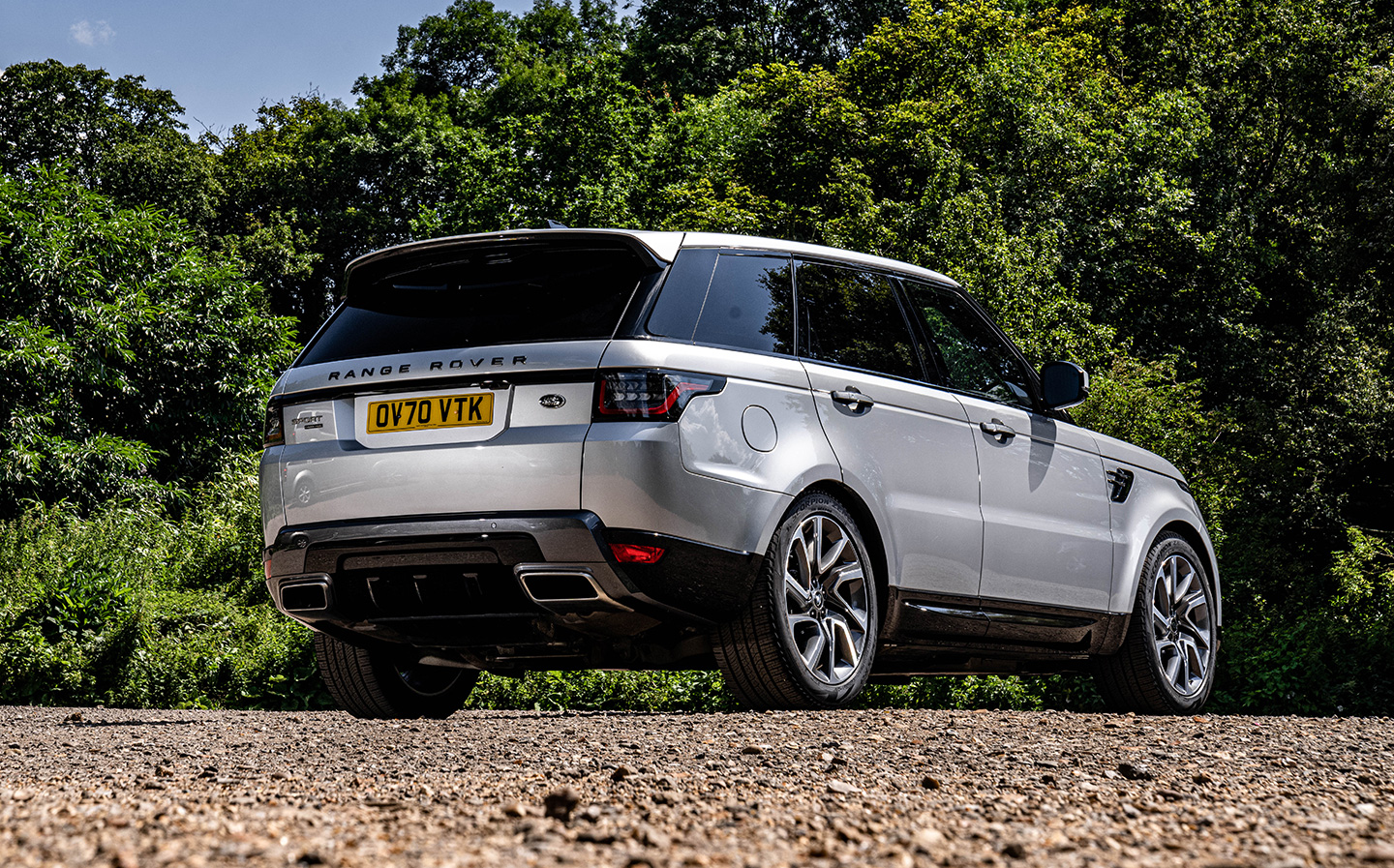
Ordering new would have meant a delay, though, so Land Rover found an example for me ready to go. It’s in HSE Silver Edition specification, which is a step up from the entry-level HSE model and adds things like a panoramic glass roof, tinted rear windows, an upgraded Meridian Surround sound system (which actually you get on the P400, anyway), heated steering wheel and front coolbox under the centre armrest. It also includes a few cost options, including three-zone climate control.
One thing I asked for, though, is silver alloys as I’m planning to go off-road with it at some point — all customers are offered a half day 4×4 experience as part of the deal — and didn’t want to scratch the black alloys that come as standard. What it means is that the car looks relatively un-gangster, which I like. As another motoring journalist said on Twitter, lose the privacy glass and “it might even have a bit of that old-money vibe of earlier Rangies”.
Above HSE spec there’s HSE Dynamic, HSE Dynamic Black, HST and Autobiography Dynamic, as well as the SVR and SVR Carbon Edition full-bloody sports versions. Prices start at £64,685, which seems like a lot of money but it’s a long way off the price of an entry-level Range Rover, which costs upwards of £83,525, and it doesn’t seem to put off buyers: Land Rover sells more Range Rover Sports in the UK than Volkswagen sells Passats.
Of course, if you buy the 400bhp plug-in hybrid, you’re looking at a significant premium over the base HSE; the P400e HSE Silver starts at over £75,000, and with options my test car will set you back £78,035.
I’ve had the car for a month now, and put it straight to use on some long journeys up the motorway. Let’s be clear, motorways are not plug-in hybrid territory, as you soon deplete the battery pack and are then asking the petrol engine to do much of the work, which rather defeats the point. PHEVs are best suited to short journeys and regular recharging.
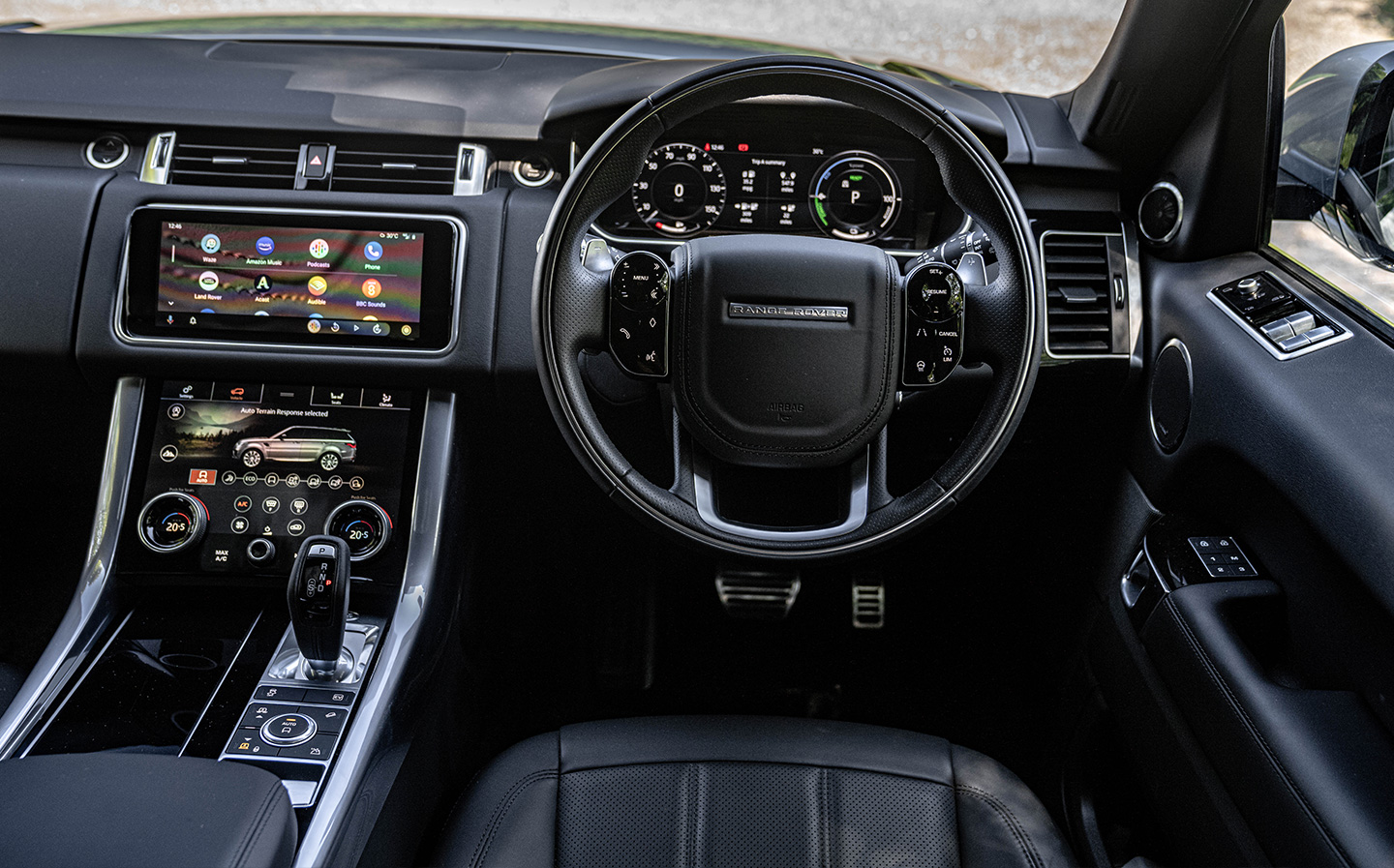
But I noticed fairly decent fuel economy, of 31mpg after a few hundred miles of motorway bashing, and I have since, through regular recharging and local journeys running on electric, got the fuel economy back up to an average of 47mpg.
My next update will be following a UK holiday with plenty of driving, so it will dip again. I’ll report on that, as well as how practical the car is for family trips.
Also coming up during my time with the car will be reports on what it’s like to drive, what it’s like to sit in, some of the tech features including the phone app, recharging, and any issues or niggles. Stay tuned.
- Mileage today 4,426 miles
- Distance since start 828 miles
- Indicated long term consumption 44.1mpg
If you’d like to ask me a question about the car, please do comment below; I try to check comments every week. I’m taking a break from Twitter until they get serious about the rampant misogyny, racism and general hate, which I’ve been fortunate to avoid but many others suffer.
September 6, 2021 Road trip: how does the RR Sport fare on a family holiday?
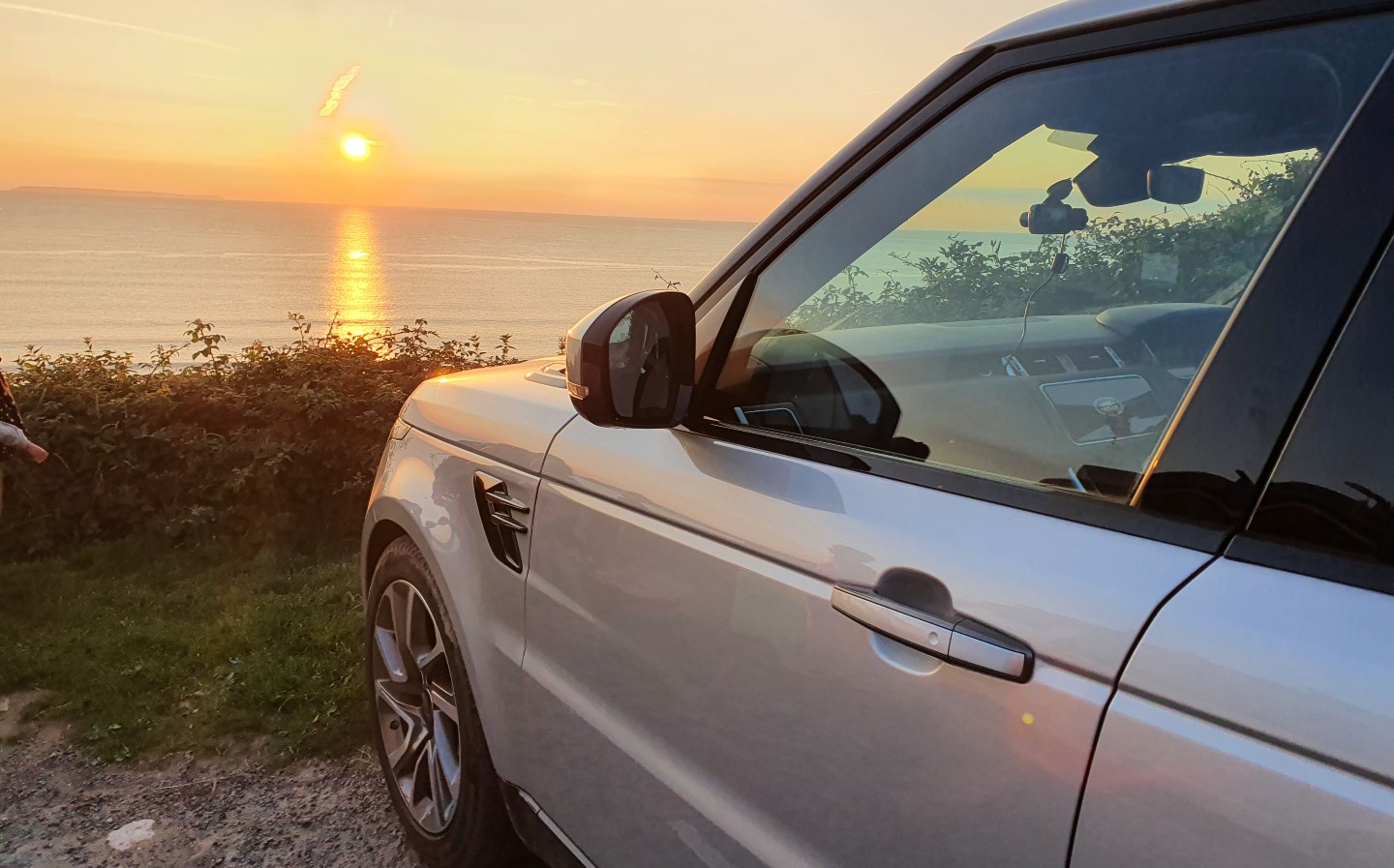
An eventful week with the Range Rover Sport on holiday in Devon and Yorkshire saw me not only add more than 1,000 miles to the odometer but also try out the car on some fairly challenging terrain, discover how good the car is with small children on board and find out what happens when you’re forced to take evasive action at 70mph on the M1. We’ll get to that.
Boot space
One concern before loading the car with luggage for four was whether we’d need a roof box. As we weren’t camping, we didn’t have all the extra camping equipment that comes with that, and my children are now seven and five, so we don’t need pushchairs and the other kit that’s required for smaller kids. With one large case, a medium-sized case and other bags, we just about managed to get everything we needed into the 703-litre boot, behind the second row of seats.
It’s worth noting here that the P400e plug-in hybrid model doesn’t come as a seven-seater, and sacrifices underfloor space in the boot (normally used for a spare wheel) in order to accommodate the lithium ion battery pack. In fact, the boot floor is 46mm higher than on petrol and diesel versions, resulting in a 79-litre reduction in overall capacity. There is a small underfloor area near the hatch, but it’s only large enough for a space number plate, locking wheel nut and tyre goo/pump, in case you get a puncture.
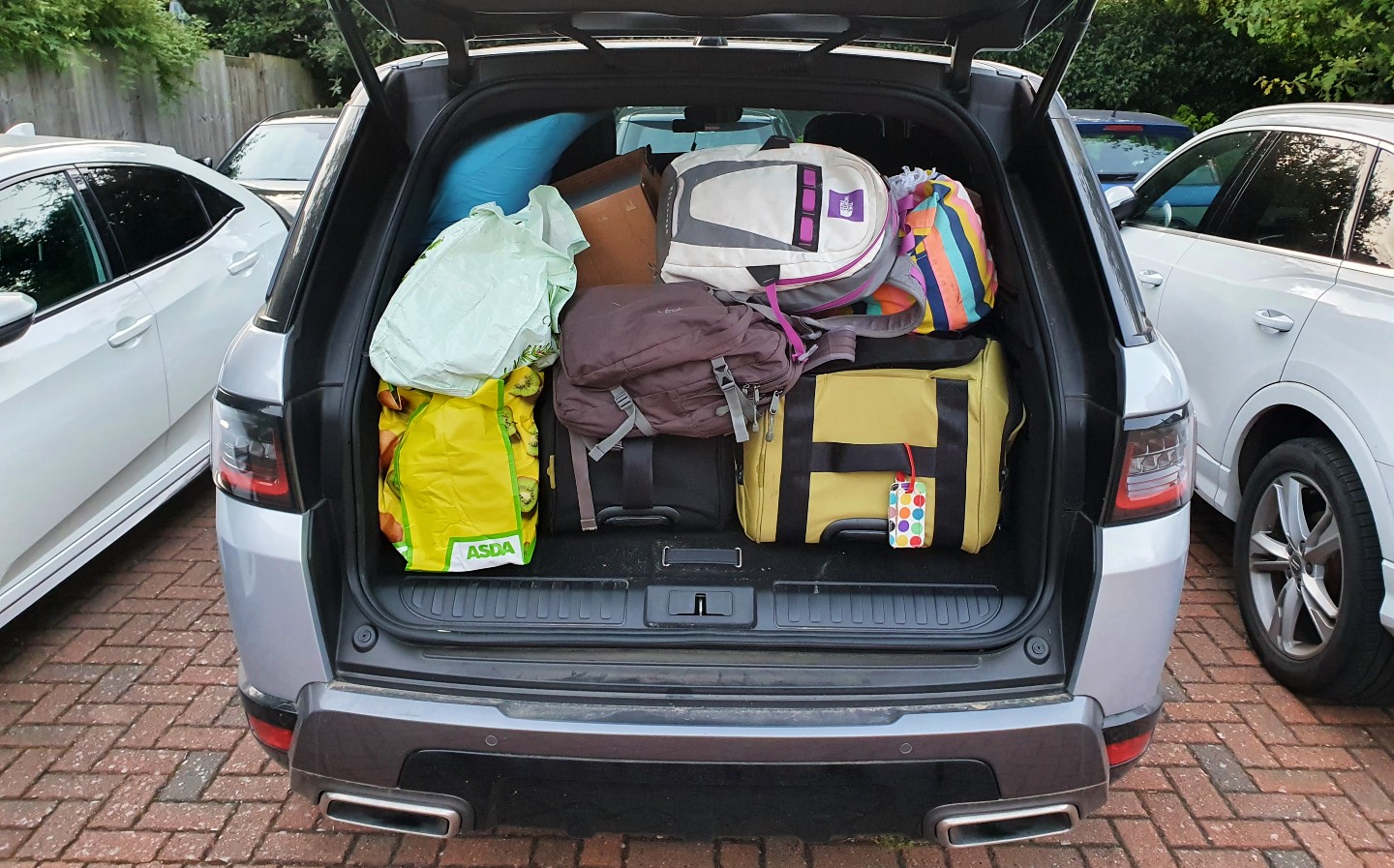
But everything we needed did fit, and the boot floor is still relatively flat, which means you can slide bags in easily. What’s more, the space is deep and square, and you can lower the rear suspension using a button inside the boot, which further aids with loading and unloading.
One thing to watch out for, though, is that catching your head on the corner of the boot lid when it’s open is very easy indeed, especially with the suspension lowered. It’s happened to me a couple of times.
The boot cover is a soft, retractable material but the end flap is hard plastic and can be turned upright behind the rear seats, helping to bags from sliding from the boot into the cabin.
Before any of you comment about it, of course before loading up and setting off, I checked the proper tyre pressures for a fully-laden car, and adjusted them appropriately as part of the usual checks pre-long-distance motoring.
Other notes on practicality
The holiday revealed a number of great features of the Range Rover Sport. We made full use of the optional refrigerated cool box under the armrest between the front seats, and I installed a couple of DVD players behind the headrests for my children, which were powered by the 12v socket in the rear.
They got used to adjusting the temperature in the rear, as our car is fitted with the optional three-zone climate control, and we kept the central rear armrest down for the duration of the holiday, as the kids found the cupholders and storage tray very handy indeed after stops at motorway service stations.
In fact, whoever designed that armrest clearly has their own children, as it has cutouts that allows relatively easy access to the belt buckles even when child seats are installed (depending on the seat design, that is).
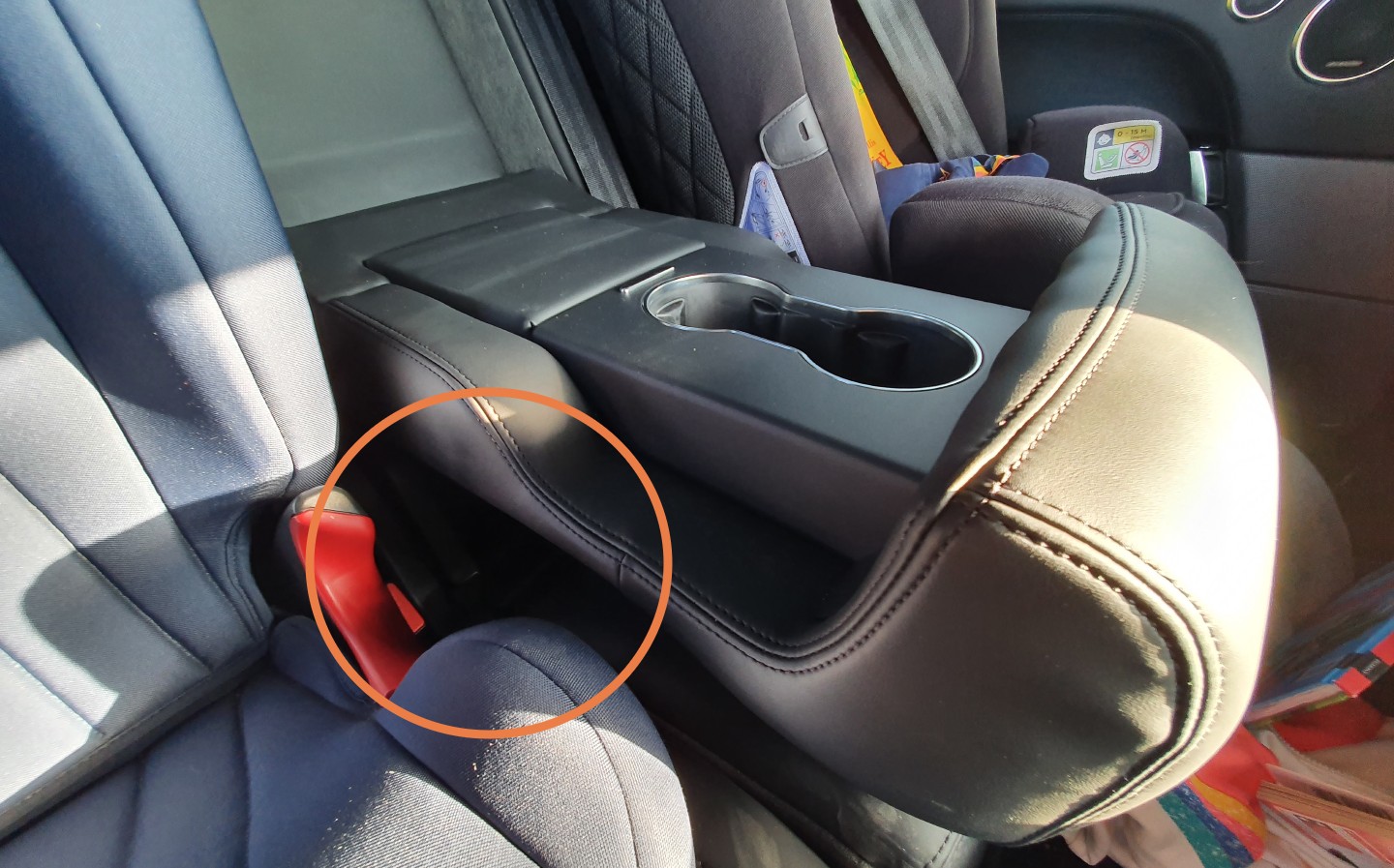
Space in the rear for the children was really good – I didn’t hear a peep of discomfort from them over the entire 1,048 miles.
If there’s a grumble it’s that all four passenger doors are quite long, and they’re deep, which means entry and egress is tricky if you’re parked close to another car or wall.
Driving notes
I would normally publish an update on what a car is like to drive before elaborating on other points, such as practicality, but the timing of my holiday means I’m doing things slightly out of sequence. Instead I will go into it in more depth over the upcoming posts, including what the car is like to drive off-road, but having covered so many miles already means I have a fairly decent handle on the way the car feels to drive; more than 1,000 miles across the UK will reveal a lot about a car’s capabilities.
Firstly, and perhaps unsurprisingly, it’s bloody brilliant for taking to the beach. The Northam Burrows car park at Westward Ho! is a mix of mud, sand and rock. Most cars can navigate it fairly successfully, but only a proper 4×4 like the Range Rover can traverse the worst ruts and muddy sections (the picture below doesn’t show those ruts, which are nearer the other end of the beach), and I deliberately crossed sections of ground that would have beached a family hatchback, or had a two-wheel drive car’s wheels spinning hopelessly. The RR Sport was exceptional, especially in the raised-suspension off-road setting.
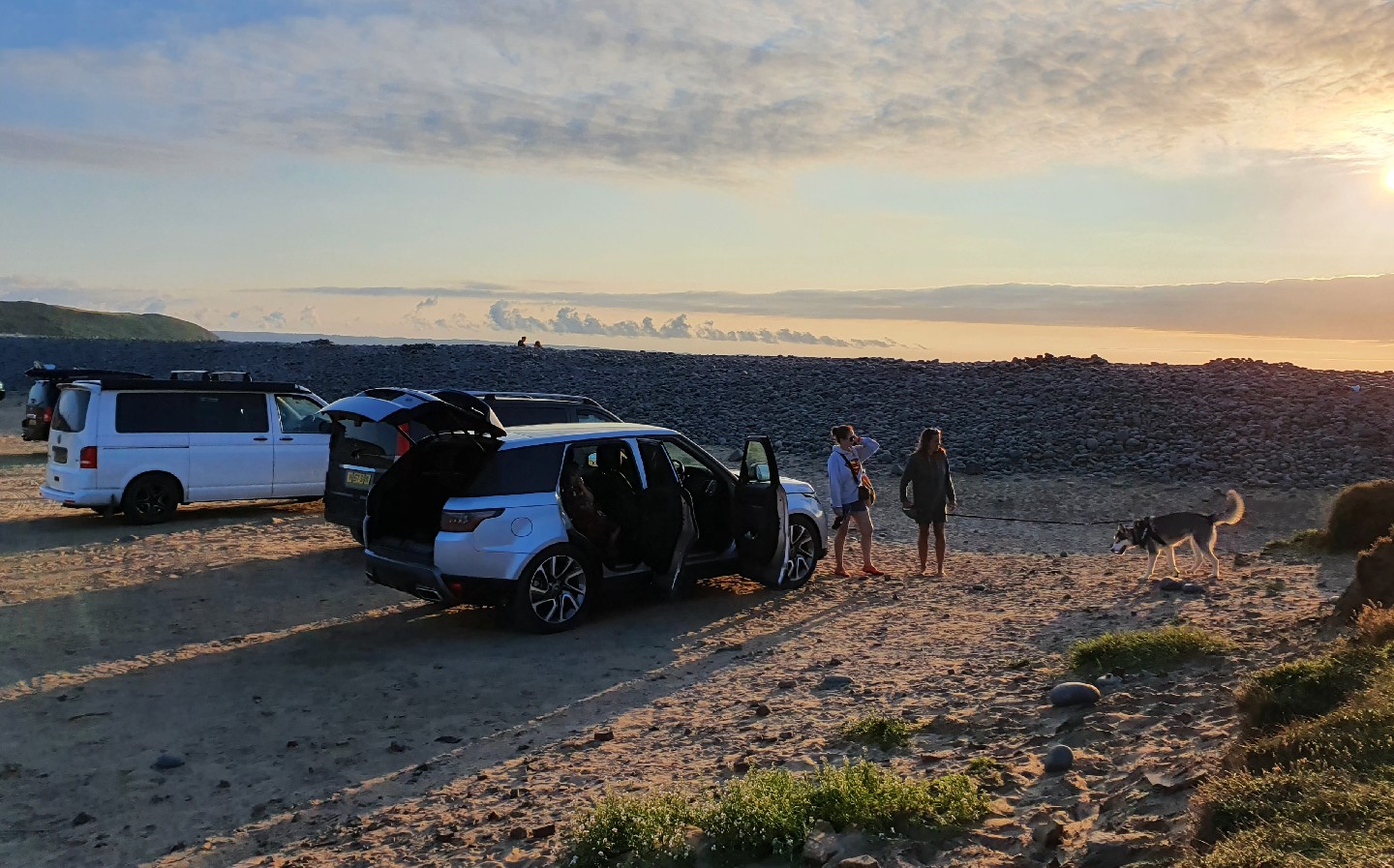
I’m not suggesting a beachside car park is a true test of the car’s off-road ability (I’ll be doing that at a later date), but Northam Burrows is probably the toughest challenge most owners will give their Range Rover Sport, and it passed with flying colours. Similarly, the raised stance means that potholed driveways that might defeat some estate cars and even some crossovers are no problem for the Range Rover.
Of course, a secondhand pick-up truck could do all this but with the RR Sport you travel in relative luxury and its air suspension means those in the cabin aren’t bounced around all over the shop.
I found that the car is most at home on bumpy country roads. On the fairly smooth suburban surfaces near where I live, which are strewn with humps and speed cushions, the suspension feels firm, but show it the undulating, creased roads through the Yorkshire Dales and it irons them out beautifully, resulting in a calm, composed, relaxed journey. Not once did my children complain of nausea, even when they were reading puzzle books or watching movies.
I also got to experience the Range Rover Sports prowess in an elk test. Though I’d rather not have.
The M1 incident
Despite their high speeds, motorways are incredibly dull to drive on. Until they’re not.
My dash cam captured the following moment while driving from Devon to Yorkshire on the M1. I was travelling at 70mph in the middle lane, overtaking a lorry, when the cars in the outside lane began to slow (hence me coming alongside) and then came to a complete stop.
The chap in the Dacia Duster next to me didn’t have enough time to stop without hitting the back of the panel van in front, so dived into my path, forcing me to jink left and right to avoid making contact. I only just managed to get away with not hitting the lorry to my left, and fortunately — miraculously — the Range Rover Sport didn’t pick up so much as a scratch.
As much as I’d like to pat myself on the back and put it down to driver skill, the car deserves much of the credit. If you look at the interior view, and the amount of input required from me to avoid what could have been a pretty serious crash, and then look at the composure of the front of the car in the forward view, you can see how brilliantly the Range Rover Sport’s air suspension and electronic stability control systems coped.
What I put the car through, basically, was an elk (or moose) test — a now-standard safety test for car manufacturers, based on independent tests carried out by Scandinavian car magazines and safety bodies, whereby you’re imagining an elk has run in front of the car and you’re forced to jerk the wheel left and right to drive around it. Some older cars struggled with it. Famously, when the Mercedes A-Class was first launched, it really struggled, resulting in the manufacturer fitting its ESP stability system as standard.
The A-class is a small car, though — the RR Sport is much taller, and it’s a car designed to tackle proper off-road courses. Yet it seemed to shrug off this incident without breaking a sweat. I was absolutely amazed. I do hope the rest of my time with the car is less exciting.
A point about charging
Public charging points aren’t exactly prolific in North Devon or Yorkshire, I found. The Asda and Tesco superstores in Barnstaple have a few 7kW posts (operated by BP Pulse and PodPoint respectively), which enabled me to almost fill the battery on one occasion during my holiday, and there was a 22kW EVCharge post at the Sandy Cove hotel (which offers stunning views across the coast to Wales), but most of the time I was relying on petrol power. This is a clear benefit of a plug-in hybrid – if you aren’t staying somewhere at which you can plug in overnight, or travelling near to rapid charging points, a PHEV is actually a brilliant option.
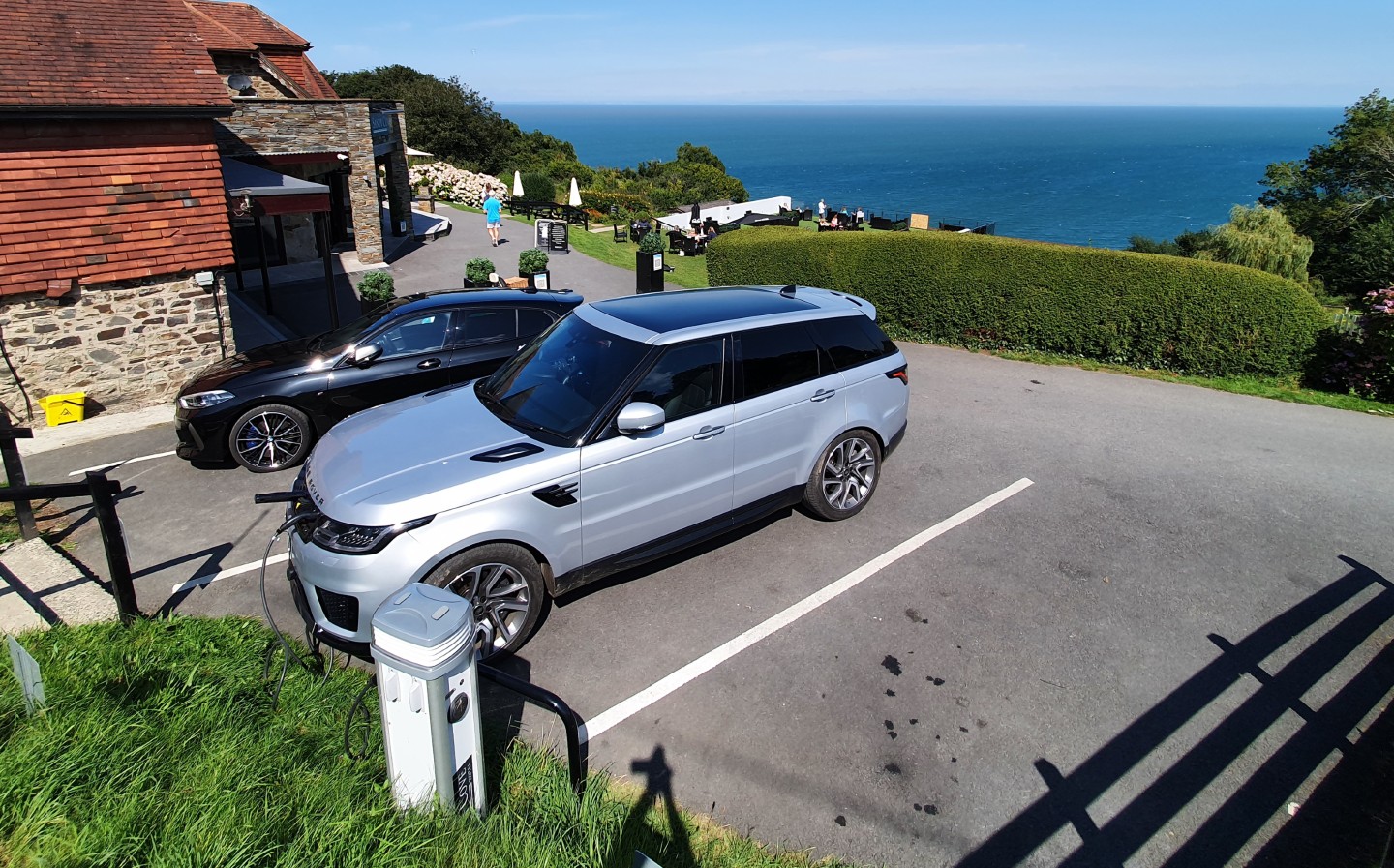
And whereas the Skoda Octavia iV PHEV that I tested earlier this year has a fairly small tank, the Range Rover Sport P400e can take on a huge amount of petrol — 91 litres — enabling long runs between refills of around 500 miles. So while it’s painful to watch the cost rising as you stand at the petrol pump (a full tank will cost you over £90 at present), it’s a comfort to know that when you get back home you can resume running on cheap electricity. I am currently looking at switching to an Economy 7 home energy tariff, so that the electricity costs me just 5p per kWh after midnight. Cheap as chips.
So, of course the average fuel economy has taken a hammering since the giddy highs of 47mpg before my holiday, and dropped as low as 36mpg by the time I returned home, but I’m already beginning to see it rise again now that I’m home and predominantly running on battery power.
- Mileage today 5,645 miles
- Distance since start 2,047 miles
- Indicated long term consumption 37.2mpg
If you’d like to ask me a question about the car, please do comment below; I try to check comments every week. I’m taking a break from Twitter until they get serious about the rampant misogyny, racism and general hate, which I’ve been fortunate to avoid but many others suffer.
November 8, 2021 How economical is the Range Rover Sport P400e, and how easy is it to recharge?
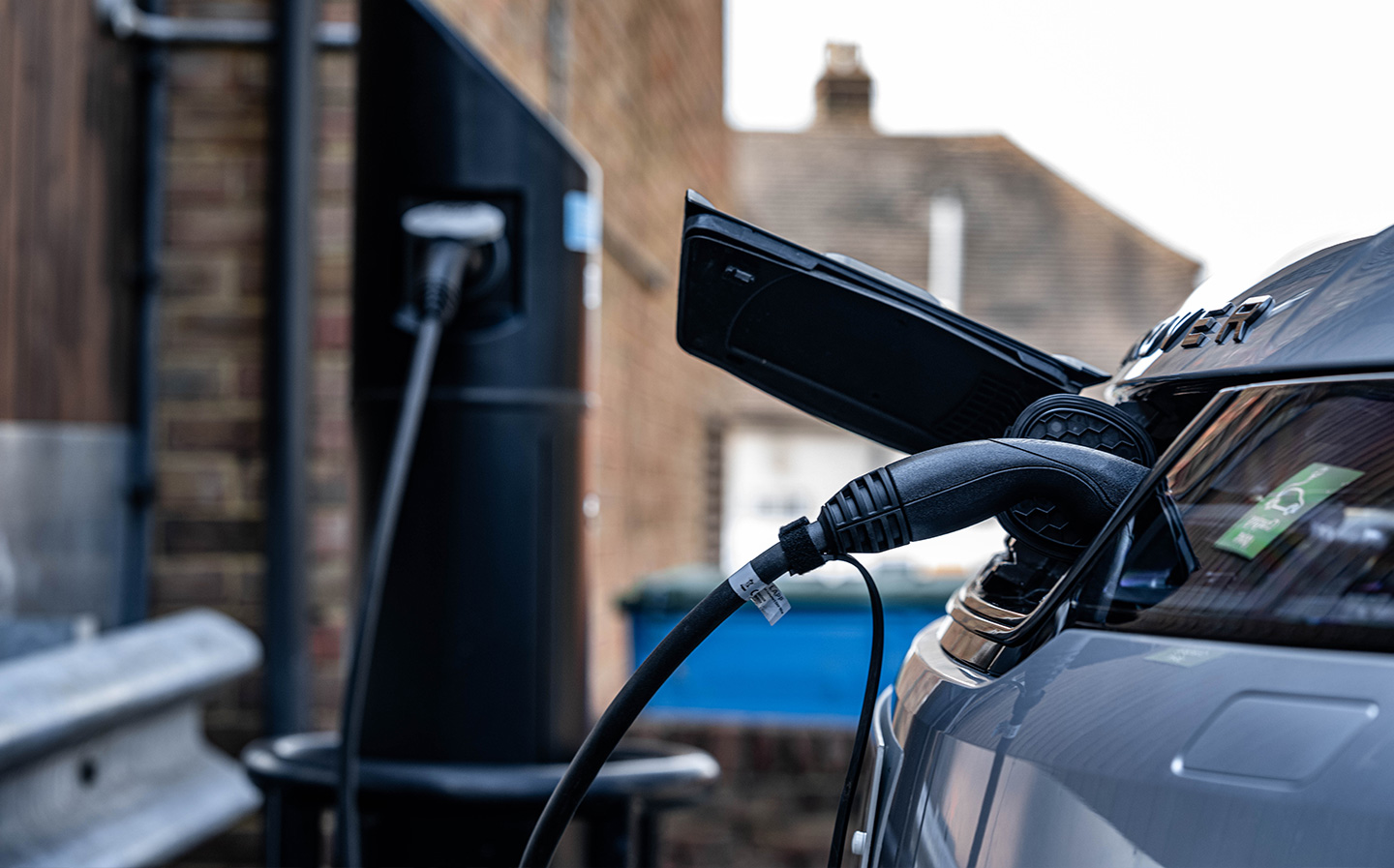
I have always wondered how many people buying a Range Rover care about fuel economy. They’re expensive cars so you could be forgiven for assuming the owner can afford £100 a week (which would be just over a tank) on fuel, or perhaps even twice that, and that fuel economy is an irrelevance. But then, we’re told, people with money often care deeply about counting the pennies.
Costs of running a plug-in hybrid aside, there may be practical questions you have about how and where I’ve been plugging in, how often and whether or not it’s worth it.
Let’s start with how I charge: anywhere I can, basically. I plug in at home overnight and have recently switched to Octopus Energy (guess what, my old supplier Green Network Energy went bust, as many are at the moment), which is a favourite of electric car drivers. Its costs aren’t necessarily the cheapest, though they are very competitive and I admire the company’s policy on transparency. There’s no pulling the wool over your eyes and trying to sign you up to a more expensive tariff on the pretense that it’s doing you a favour, which is exactly what EDF tried to do when it took on Green Network customers.
But with Octopus (which isn’t paying me for publicity, by the way), I’ve also managed to switch to their Economy 7 tariff, called Octopus Go, which charges around 14p/kWh during the day but that drops to 5p/kWh between 00:30 – 04:30 every night, representing a massive saving by scheduling the car to charge between those hours — I’ll get to how you can do this with the Range Rover Sport in a minute.
First, it’s worth pointing out that if you are fortunate enough to be able to fit a wallbox charger to your home, with power output of around 7kW or 11kW (which are the standard options today from most installers), charging can take as little as 2.5 hours — easily enough to full charge from empty during the cheaper hours of my tariff. Land Rover has some recommended suppliers, and installation can be arranged through your friendly neighbourhood dealer. As part of the deal, negotiate the optional “Multi-function Charging Cable” (aka a Mode 2 cable, which is the standard at most AC public charging points). You may find a wallbox comes with a “tethered” Type 2 cable, which is more convenient for easy plugging in and unplugging, but a separate cable is an essential purchase anyway for when you’re away from home.
However, I don’t have a home wallbox as it’s impossible to install one at my home (long story but I have had engineers from Chargemaster (now BP Pulse) and Pod Point visit and it would involvecutting holes through my house and lifting slabs in a shared car park managed by our housing estate, which means lots of red tape. So I charge using the three-pin Home Charge cable, which is supplied as standard with the car and plugs directly into a regular wall socket mounted at the end of my garden.
I’m lucky I’m able to do that, though: around 25% of UK drivers are thought to park on the street, or up to 60% in London. If that’s you, don’t run a cable from your house out to the car across pavement — instead, lobby the local council to install chargers on your street. Lamp post chargers are a great idea, and the cables provided with them are linked to your own energy tariff.
Of course, charging via a three-pin socket at 13 amps draws power more slowly than from a dedicated wallbox. At up to around 3kW, a full charge of the P400e takes up to 7.5 hours. That means some of the charge is at my regular 14p/kWh, but I still get at least half at the 5p/kWh rate.
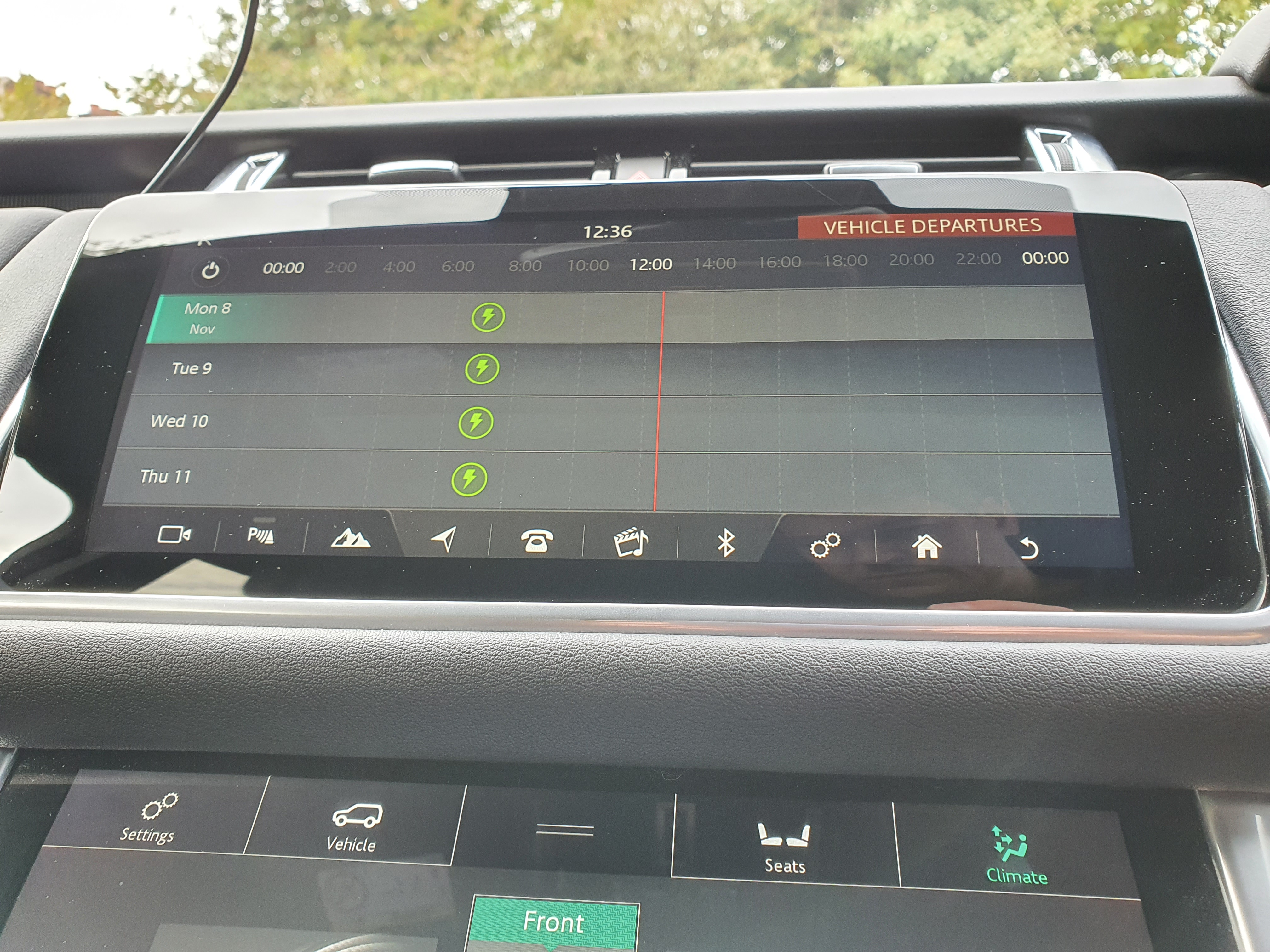
Scheduling should be easy, but I found that setting the “Charge Period” via the Land Rover mobile app wasn’t enough — for some reason the car still started charging any time I plugged in. There is a second option, though, which I set via the vehicle’s touchscreen. Swipe left from the main menu and you get a My EV sub-menu, and from there you can swipe again to set “vehicle departure” times. Basically, you’re telling the car to be ready to go at a certain time each day, and you can adjust it per day of the week (which is handy if you drive to the office three days a week instead of five, for example). You can set the timer for both climate control, so that the car is toasty warm and defrosted when you climb in, or charging.
I have told the car to be charged by 7am each day (adjusted from 5am in the pic below), and combined with the charge period of between 00:30 and 7.30am, that seems to have done the trick. Now when I plug the Home Charge cable into the three-pin socket at the end of my back garden (it was installed by an electrician specifically for the task of charging EVs, so I know it is safe), the car waits until after midnight before actually sucking the juice from its straw. And if you turn up at a public charger and want to charge at any other time? When you switch off the car a message flashes up to ask if you want to charge now, so it’s easy to override ad hoc.
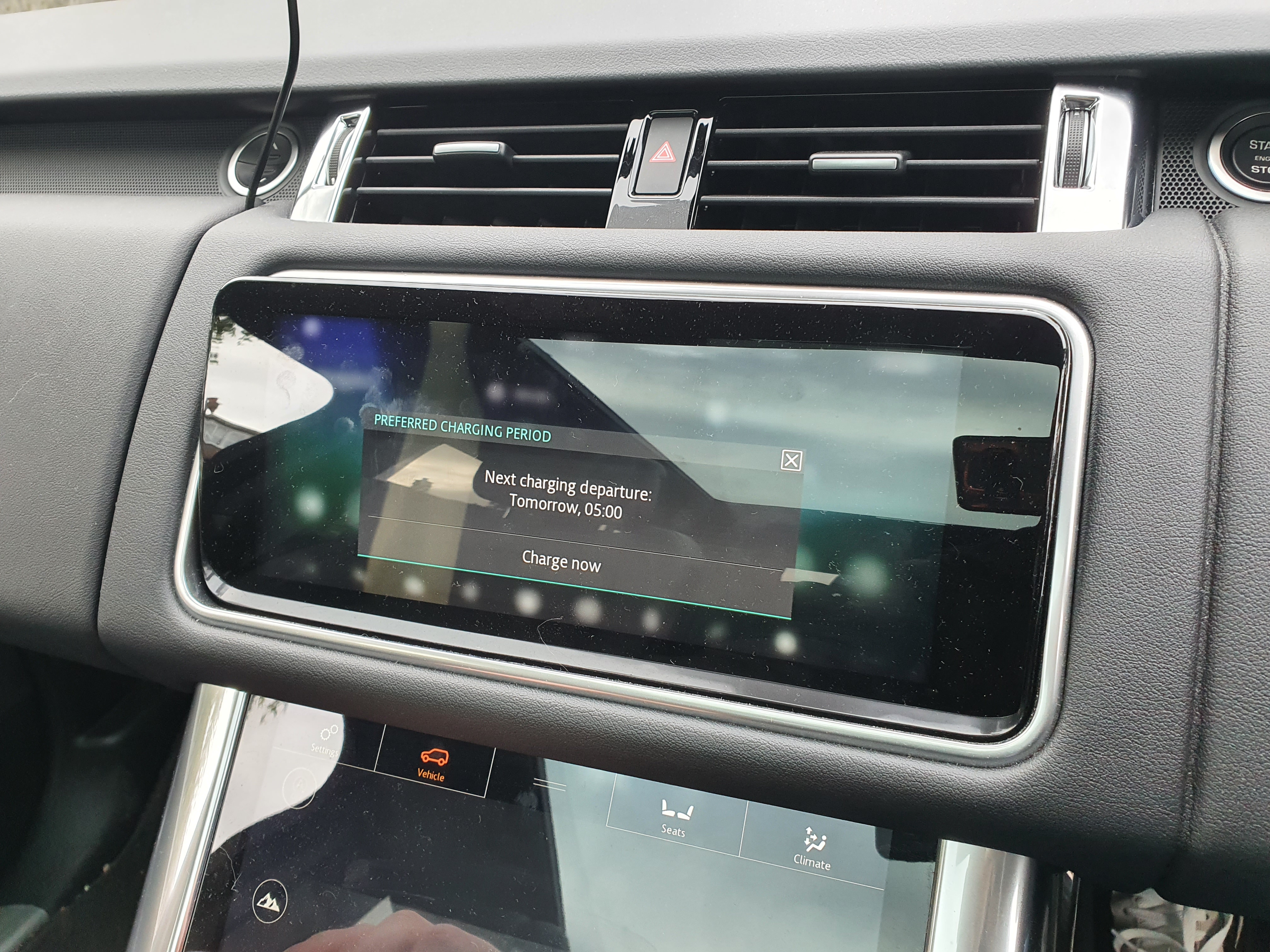
Is it essential to plug in every day? No, not at all, but you’re wasting money if you don’t, not to mention creating unnecessary emissions. I mentioned in a previous post that on long motorway journeys the Range Rover Sport gets about 31mpg. That, or potentially worse around town, would be the norm so you’d be visiting the petrol station fairly regularly. With prices currently at record highs, that’s not a smart choice.
If your employer pays for your fuel then you may be inclined not to bother increasing your home electricity bills, but on your conscience be it — you’re spewing unnecessary carbon into the atmosphere. Shame on you. Instead, come to an agreement with your employer to pay the additional electricity charges, over and above your previous usage, each quarter.
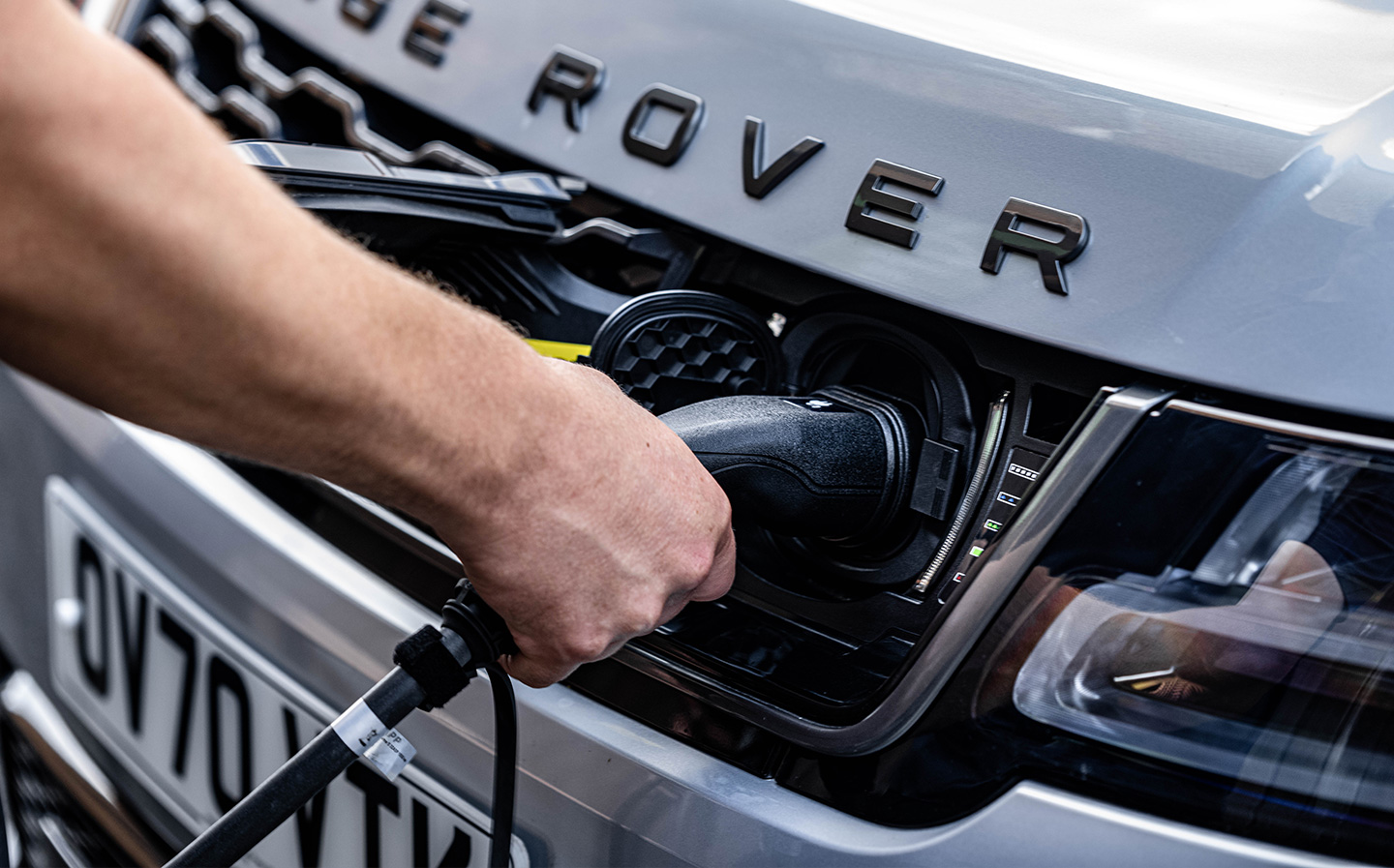
When driving around town, I will always press the EV button to maximise zero emission driving. I actually get a kick from trying to put off visiting petrol stations, not least because I was horrified at the amount of money it cost me the last time I did (which was before the last update, as I’ve not had any really long journeys to make in the last couple of months). I’ll need to fill up again later this week, as I’ll be heading to Oxfordshire to drive a couple of interesting cars, but since my summer holiday I’ve watched the average fuel economy creep up from 37.2mpg at the last update to 46.8mpg today. That’s over the entire 3,038 miles that I’ve driven the car, meaning I’ve burnt 65 gallons of petrol, or 295 litres — around three and a half tanks since July.
I’d love to tell you how many kWh of electricity it’s consumed on top but that’s a bit trickier, as it’s not obvious from the readouts. I’ll compare energy costs from before and after I started running the car and get back to you on that, but a full recharge at 5p/kWh would cost 65.5p and with an official electric range of 25 miles that’s 2.62p per mile. Even if you recharge at a cost of 14p/kWh, that’s still only 7.33p per mile. Now you know why I plug in whenever I can.
One last thing: as expected, the colder weather is impacting range. Whereas I could expect up to 31 miles of electric driving indicated during warmer weeks, the car reckons around 21 miles is more likely when the mercury drops. This is common with battery-electric cars, as the cold plays havoc with the lithium ion chemistry.
- Mileage today 6,637 miles
- Distance since start 3,038 miles
- Indicated long term consumption 46.8mpg
If you’d like to ask me a question about the car, please do comment below; I try to check comments every week. I’m taking a break from Twitter until they get serious about the rampant misogyny, racism and general hate, which I’ve been fortunate to avoid but many others suffer.
January 5, 2022: What spec and options for the Range Rover Sport?

Let’s say I’ve found a pot of gold behind my sofa and suddenly have the £75,000-plus to buy a Range Rover Sport PHEV. The first thing I’d want to know is how long it would take to be delivered.
The good news is that, as a motoring journalist, I can WhatsApp? someone at Land Rover to get the answer. The bad news is that it’s not good news.
Because of the global shortage of semiconductor microchips, which is plaguing all tech manufacturers (in cars, the semiconductors are part of circuitboards that govern everything from the stability and safety systems to digital displays in the cabin), according to my contact if I were to place an order for a Range Rover Sport P400e today using Land Rover’s online configurator, it could take between nine and 12 months to get to me.
There was a caveat, I was told: it varies from week to week, so it could be sooner or later than that, depending on chip supplies. But I’d need to be prepare for the fact that it could be Christmas 2022 before I got behind the wheel.
UPDATE Jan 28, 2022: Land Rover has now stopped taking orders for the Range Rover Sport due to the semiconductor supply issue, and no doubt also because a new model is reumoured for launch later this year.
Let’s assume that’s not an issue and I’ve found myself on the configurator… what specifications and options would I go for?
Spec is always subjective — that’s why some people insist on driving around in pink cars with eyelashes on the headlights — but having lived with the P400e HSE Silver for a good number of months now, I have some thoughts.
Here are the things I would definitely load onto my own Range Rover Sport, as well as the ones I’d not for out for.
Which trim is best?
Land Rover calls its trim levels “Models” on the configurator, though as far as most people in the industry are concerned, “Range Rover Sport” is the model. What we’re talking about though, is the basic specification of the car before any optional extras are applied, including the exterior paint colour, interior upholstery and on-board technology. I’ll tell you what I’d go for after a walk-through of the four versions.
My test car is in HSE Silver, which is actually the entry-level for the P400e (there’s HSE below that, but only for the least powerful petrol and diesel versions).
Prices start at £75,495, and for that you get Matrix LED headlights, privacy glass (tinted windows to you and me), Windsor leather 16-way heated memory front seats, a heated steering wheel, all-round parking sensors, a reversing camera, Android Auto & Apple Carplay and all the off-road Terrain Response 2 gubbins. It comes with a panoramic sunroof, Meridian Surround Sound stereo and the rear seats are even heated. Basically, it’s not lacking in features.
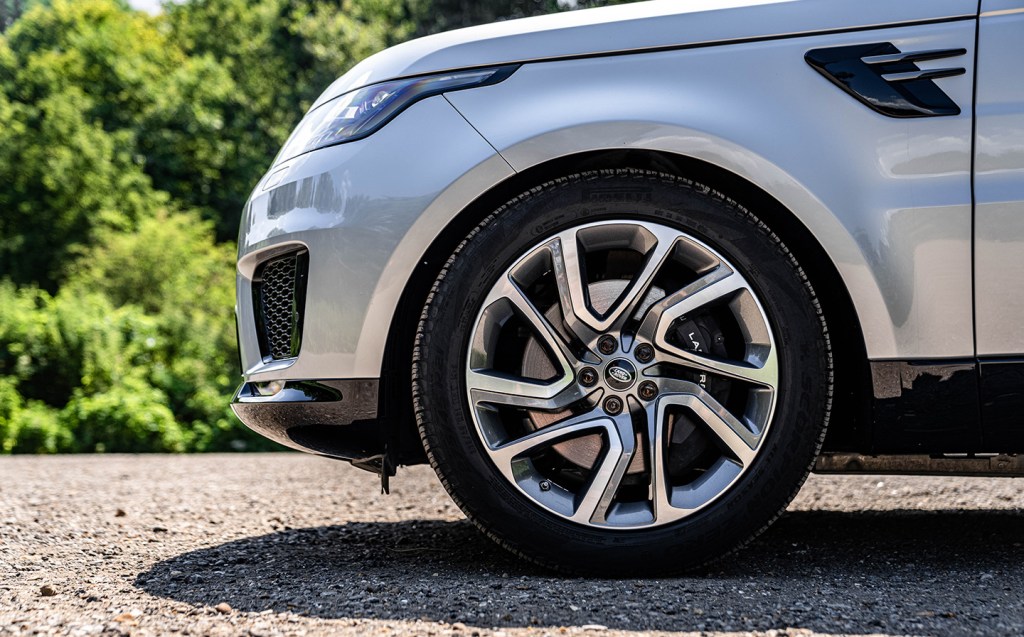
What could the more expensive trims possibly offer? Well, for an extra £500, the HSE Dynamic model comes with different (but still 21in) alloys. My test car should have 21in “Style 5007, 5 split-spoke Gloss Black with contrast Diamond Turned” wheels, though I asked for the HSE Dynamic’s Gloss Sparkle Silvers to be fitted instead, mainly because I was worried about taking the part-black alloys off-road (that will be my final update on the car, so stay tuned) and marking them.
HSE Dynamic also gets illuminated door sills and some different materials inside as standard: a citrus headlining and ebony black leather interior. Again, my car borrows the HSE Dynamic’s spec here: an ebony interior, which can be optioned on the HSE Silver at no extra cost to replace the Ivory headlining and seats.
Weirdly, the HSE Dynamic loses the front centre refrigerated compartment; that’s available on all other trims, including the HSE Silver. Everything else is basically the same.
Then there’s the HSE Dynamic Black, available for just over £4,000 more than the HSE Silver. If you want a “murdered out” version of the Range Rover Sport, this is the one to go for, as it includes the Black Exterior Pack, with black paint and wheels (21in or 22in), rear privacy glass (tinted windows). Even the badging, vents and grille are blacked out. And, of course, it comes with the ebony interior.
Top of the range (rover?) is the Autobiography Dynamic, from £86,675, which naturally gets all the trimmings: unique alloys up to 22in; an opening panoramic roof; posher seats with cooling as well as heating, extra adjustment and plush, winged headrests; an extended leather pack with ebony “suedecloth” headlining; thicker carpets; three-zone climate control (all the others have two-zone as standard) and some extra driver aids.
If you’re wondering what the “Dynamic” means on the versions above HSE Silver, I’m waiting for confirmation from Land Rover but judging by the press material available, I can’t see any dynamic difference at all. HSE Silver also comes with a Dynamic drive mode, which governs the suspension and electronic active differential with torque vectoring (which brakes the inside wheels through a corner, to help the car turn).
Sorry, a lot of words here but it helps explain why, really, I would be quite happy with the HSE Silver version. Especially as getting the ebony interior is a no-cost option. But there are a couple of options I’d go for.
The options to pay for (and the ones to ignore)
So assuming you’re getting the HSE Silver… of the cost options fitted to the car there’s one I wouldn’t want to do without. For £220, the heated, electric folding, memory door mirrors with approach lights and auto-dimming on the driver side definitely seems worth it. It means that when your partner borrows the car, everything (including the mirrors) can be set to their preferred setting automatically via the memory function. Then reset when you get back in.
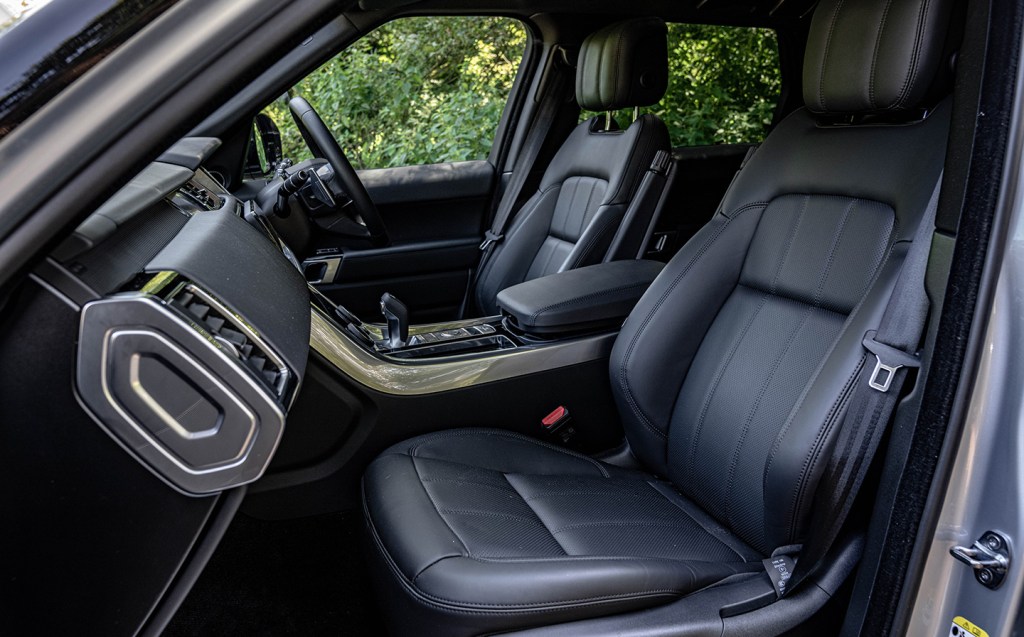
And having the side mirror dim when someone is following behind with full beam headlights is excellent for avoiding being dazzled on a dark winter night.
Nearly £900 for silver metallic paint? I’m not saying it’s overpriced – it’s a nice shade, for sure – but I might be just as happy with the standard Fuji White paintwork. Perhaps not with keeping it clean, mind you.
I personally would have liked the HSE Silver’s ivory interior, though the black version costs nothing extra, if you want it, so if you’re worried about dirt and marks it’s probably worth it, for sure. But the Ebony Morzine headlining is £330 – not for me, thanks.
For £490, you get the three-zone climate control. That’s extra comfort for rear passengers but my small children like to play with the dials using their feet, so I find I have to readjust the rear temperature via the front touchscreen, anyway, to prevent a war between the extreme temperature in the rear and the moderate settings in the front. Maybe one to go for if you’re more likely to transport older children or adults.
The last of the options on my test car is the Drive Pack, which includes a blind spot monitor, driver condition monitor, traffic sign recognition and adaptive cruise control. All useful but for £520, I might give that one a miss, too, as the standard safety kit is pretty good.
There are plenty of others to plump for on the configurator, mind you. I might consider the heated and cooled front seats for £545 – a godsend when it’s hot. Can also ventilate the rear seats if that’s a priority.
The Meridian Signature Sound System is a step up from the base Meridian stereo, and yeah, that would be fantastic, but for £4,435 it’s a tough one to justify. If you have kids, though, the Entertainment Pack with built-in TV, 8in rear seat displays and a domestic three-pin plug socket could be really useful on long journeys. That’s £2,210 at present, so you might want to go for tablet holders instead, but the built-in system is cable-free and looks much neater. You also get the plusher winger front headrests as part of the package.
I might also consider the 360-degree cameras, as it does make manoeuvring such a big car easier in tight spaces. I’ve had no problems so far but I recently tried a Volvo XC90 with 360 cameras (more on that next time) and it reminded me how brilliant those systems are. If you want wade sensing, the 360 cameras and dimming side mirrors will be added, too, for a total cost £1,250.
The Advanced Tow Assist for an additional £185 (assuming you have the 360 cameras) will be useful for anyone with trailers, too.
- Mileage today 7,619 miles
- Distance since start 4,021 miles
- Indicated long term consumption 44.8mpg
If you’d like to ask me a question about the car, please do comment below; I try to check comments every week. I’m taking a break from Twitter until they get serious about trolling, which I’ve been fortunate to avoid but from which many others suffer.
January 28, 2022 Oh, bugger: An off-roading high followed by reliability low (final report)
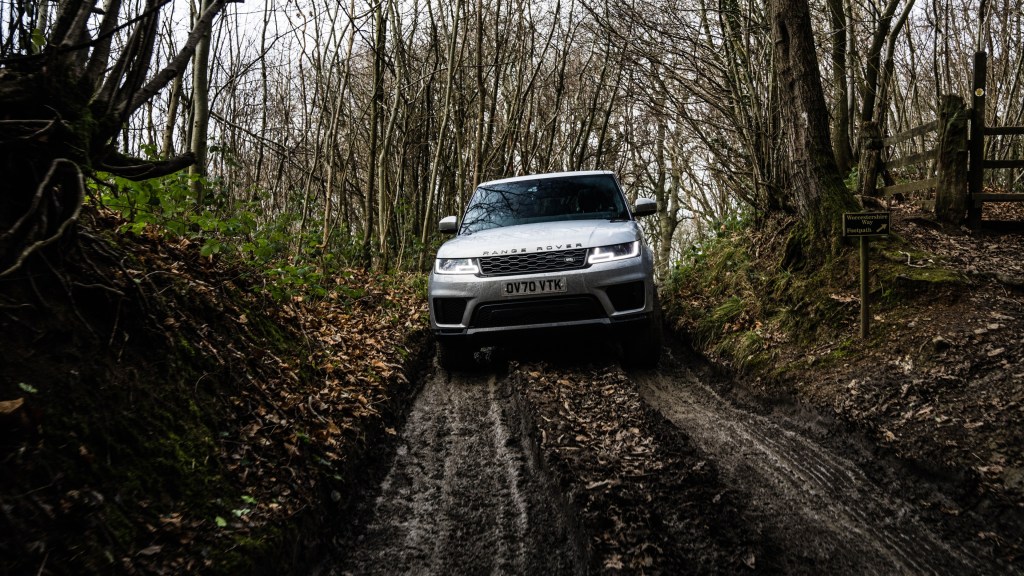
It had all been going so well. A visit to the Land Rover Experience off-road centre at Eastnor Castle, on the Welsh border, had been eye-opening. The Range Rover Sport had performed faultlessly around the punishing route – the same one used as a proving ground for all Land Rover models since 1961. Tough inclines, steep descents, side slopes, deep (and I mean deep) wading pools – the P400e brushed them all off without breaking a sweat. And all on its regular road tyres.
All customers are offered a free half-day off-roading experience, whether they’re buying a new, nearly-new or approved used car. It’s a great perk and really shows what the cars can do when the going gets tough. Normally, customers would be driving one of the fleet of cars maintained by the experience centre but I had insisted on using my extended test car, which is quite normal for journalists, I was told. It makes sense, as you know that the car you’re driving hasn’t been modified in any way to suit the off-roading course.
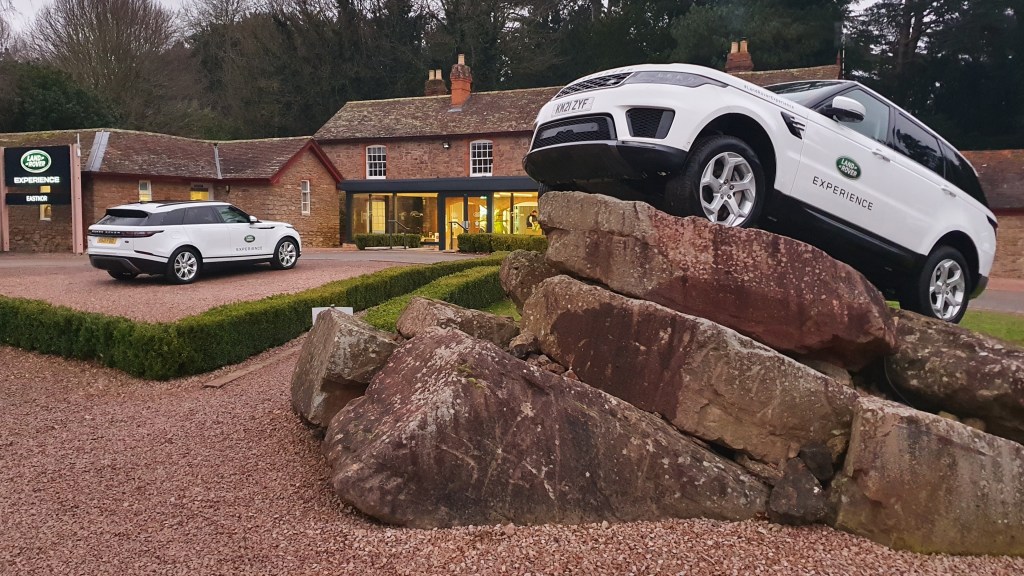
In the wrap of the video I was filming (which is to follow), I waxed lyrical about how brilliant the P400e had been during my near-seven months with it, both on-road and – as had just been proven – off it. The only problem I had with the car, I concluded, was that it was being collected by Land Rover the following week.
Those proved to be fateful words, as it turned out, as within a few hours I was standing by the side of the M4 looking at a very sick car.
The first sign of trouble was when I returned to the Land Rover Experience centre after my 4×4 excursion to plug in at a charging point. “High Voltage System not available,” the digital driver’s display warned me. Huh. Was it because I had drowned it in the off-road course’s wading pools? Maybe it just needs a moment to dry out?
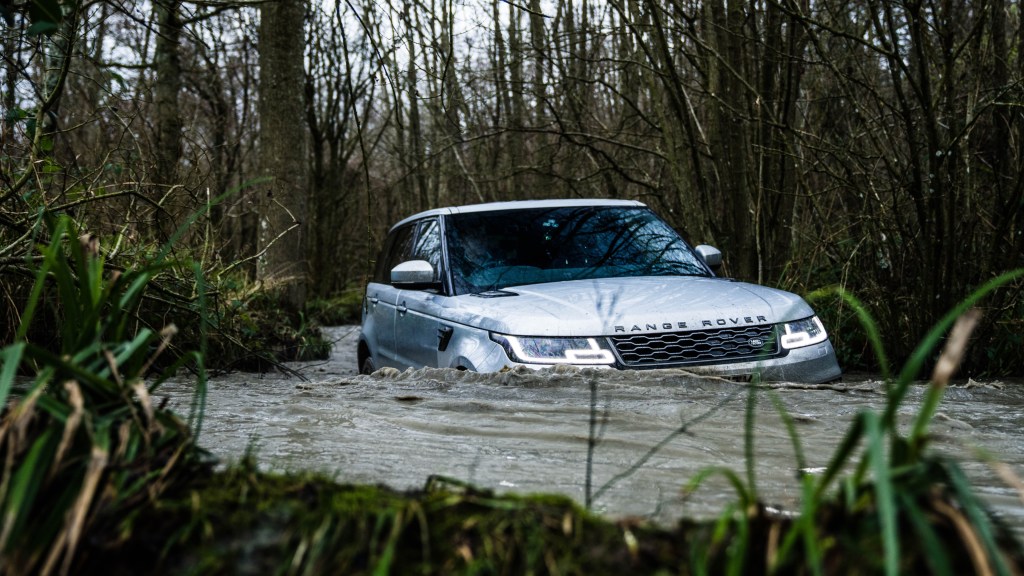
Definitely not, I was told as I handed over the keys to one of the Land Rover team; the Range Rover Sport can go anywhere the Discovery and Defender can, I was told, and its wading depth is 850mm (see the same figure as quote on the JLR website below).

During the filming I had queried this, too, and with one eyebrow raised asked, “Even the plug-in hybrid?” Yes, I was assured – the high voltage system is a sealed unit, with no chance of water ingress, so the wading depth is exactly the same.
Before returning to the experience centre the car was given a thorough jet wash, but that couldn’t have caused the initial warning to flash up, surely? That would be ridiculous.
A short time later I was handed back the keys. All seemed to be working, I was told, and it was on charge. Except when I returned to the car to set off home I noticed it hadn’t been charging at all.
Mind you, the car hadn’t charged when I first arrived, either, which makes it hard to determine if the issue was related to the off-roading, or one that had started to occur on the drive to Eastnor. I had initially assumed the charging point was faulty, because that’s the most common problem when using public chargers and I’ve not had any issues when plugging in elsewhere.
The beauty of a hybrid, of course, is that even if you can’t get a charge, it has an engine and petrol tank. Maybe all will be well when I get home, after a blast down the motorway. As I left Eastnor, I pressed the battery Save button via the Touch Pro Duo infotainment screen, to make sure I had some juice left when I reached to my home town (it was reading just over a quarter full).
Just over an hour later, shortly after joining the M4 near Swindon, the throttle pedal went limp and another warning popped up: “Gearbox fault detected.” Ah, that really doesn’t sound good, I thought.
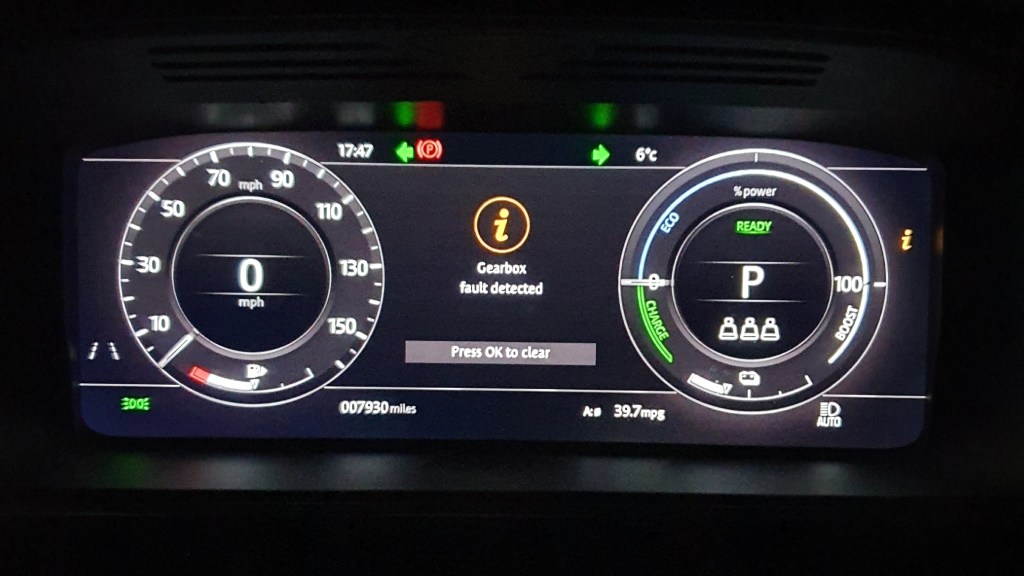
The following messages are hazy in my memory but I believe I was told to put the car in Neutral, which I did, and the car continued coasting along the carriageway.
Can I now get it back in Drive, I wondered? No dice, so I pulled onto the hard shoulder (thank god it wasn’t a smart motorway section) and stopped, then tried the old IT Crowd switch it off and on trick. That didn’t help – the car found no gears, and more warnings were beginning to appear on the digital driver’s display, including one for a suspension fault.
I had just enough time to take a couple of pics of them before launching myself into the passenger seat (no easy task in the Range Rover, I discovered) and out of the car on the near-side, away from the live traffic. Having read and written news stories about how dangerous the hard shoulder can be, I knew I had to get out of the car as a priority.
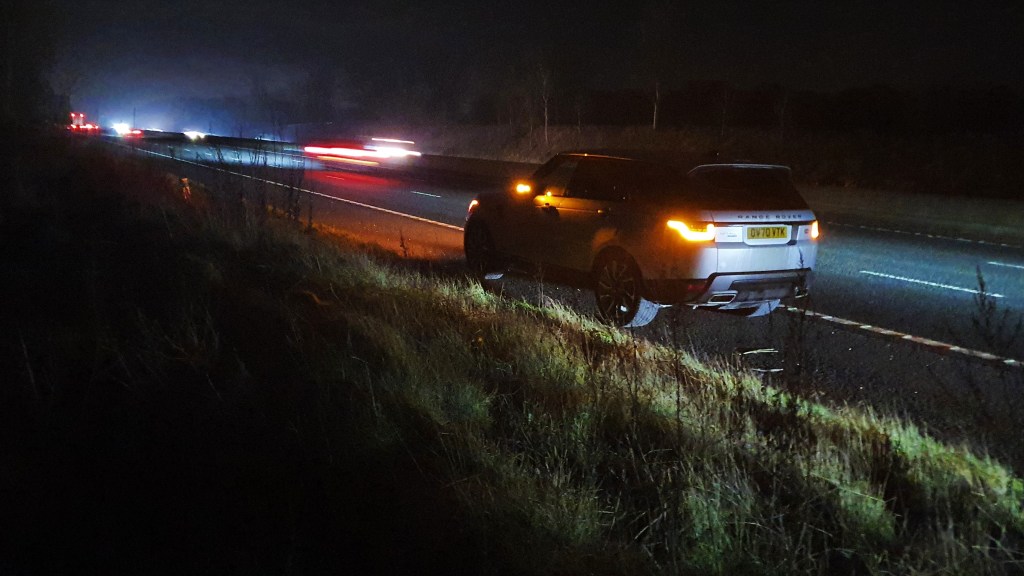
The AA was helpful at first. After handing over my details, I received a callback within a minute or two from Land Rover Assist, which, it later became clear, is run by the AA. That’s efficient, I thought, but given that I’m on a motorway, it’s unsurprising that I‘d be a priority.
The recovery truck arrived 25 mins later. As I had imagined, Alex, the driver, had trouble getting the Range Rover Sport P400e on the ramps, because it has both electronic four-wheel drive and an electric motor connected to all four wheels (one of the cool things about off-roading that day was finding that you can do so silently in EV mode, using the low range transmission).
Even getting the plastic skid plates under the wheels was difficult, due to the car’s substantial weight. But after 12 minutes (which is an age when you’re on the hard shoulder of a motorway – recovery service workers truly are heroes who put their lives on the line) we were away.
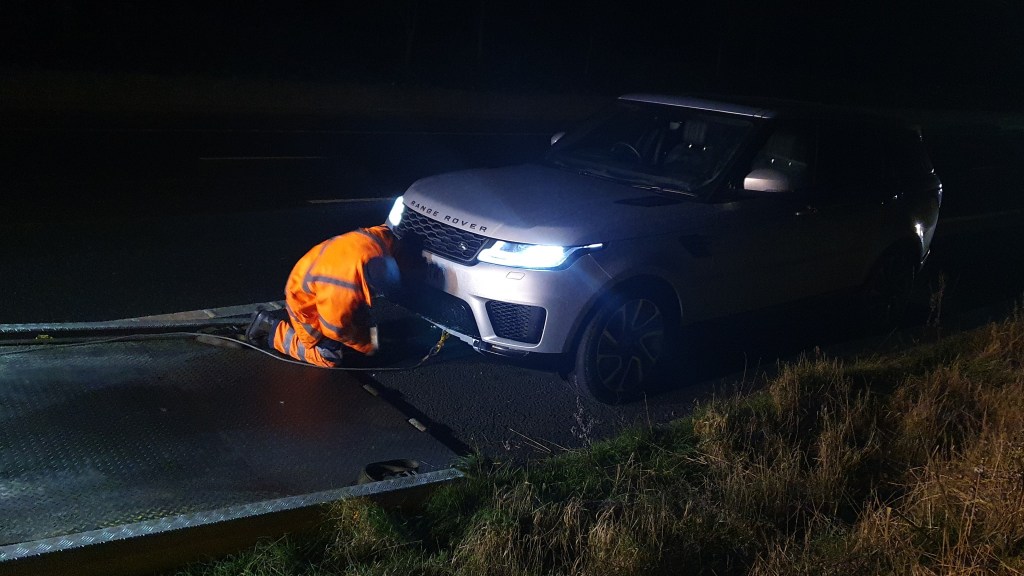
Sadly, this isn’t where the bad news ends. Alex didn’t drive me home, he dropped me at Membery Services, which was the next turning off the M4. The AA patrol would be with me in about half an hour, Alex said, to see if they can get the car started. If not, they’d get me home.
Before he left I asked, “Just out of interest, I hear a lot about Land Rover reliability but do you do a lot of Land Rover rescues?”
He laughed. “Oh, yes. Sometimes I do four or five a day.”
Four or five a day?! That can’t be right, can it? It’s still a comment that boggles my mind.
Sadly, it’s backed up by Which? The consumer organisation’s most recent car reliability report, based on a survey of owners, warns it is the least reliable make of car out there and warns: “Do you enjoy spending time in mechanics’ waiting rooms? Then Land Rover is the brand for you.”
Which found the average fault rate for cars less than three years old across all carmakers is 23%, and the breakdown rate is 3.3%, but 40% of Land Rover owners with a car aged less than three years old had to report to a garage in the last year, with 5.5% (or just over one in twenty people) experiencing a complete breakdown.
The report can be found here but common faults involved software, problems with the exhaust/ emission system, engine management system (ECU), and batteries that depleted before their time.
And faults increase as the cars get older, accoridn to Which?, so anyone buying one that is between three and eight years old should make sure they have breakdown cover.
Speaking of which, 45 minutes after Alex left me at Membery Services, I called the AA. “Yes, we can see the patrol is 30 minutes away,” I was told.
An hour later I was still sitting in the car, with the high voltage battery now completely flat and the 12v system draining. There was no heating as the car wouldn’t start. The dashboard was still telling me everything that was faulty: gearbox; stability systems; adaptive cruise control; engine temperature sensor; hill descent control.
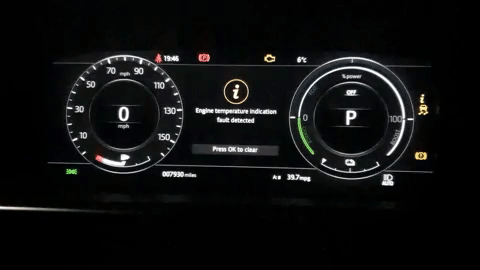
I called the AA again and was put on hold for a long time. “Hello, er, yes I don’t know what’s happened here but you’re not down on our system at the moment, so no-one is scheduled to come to you. I’m just speaking with Land Rover Assist to find out what happened.”
Brilliant. Long story short, a taxi was arranged to pick me up and take me home, with the Range Rover to be collected the following day.
I was asked me to leave its keys with someone behind a counter somewhere at the service station. Amusingly, the people working at WH Smith were well versed in this procedure, and even had special plastic baggies for the key fobs of stranded motorists. The bags weren’t Land Rover branded, I noted.
As I knew I was unlikely to ever see the car again, I had cleared it of all my possessions, including child seats, dashcam and so on. I tried the start button a couple more times and noticed the instrument display would turn on, then power off again immediately. It was like witnessing the car take its last breaths.
The taxi took another 45 minutes. I had left Eastnor at around 4.30pm, expecting to arrive home at 7pm, but it would be a quarter past midnight before I got to my front door.
Land Rover has just revealed details of its new plug-in hybrid Range Rover. The official electric range is 70 miles, which is very impressive compared with this car’s 31 miles, and no doubt the next Range Rover Sport, due (it has been reported) later this year, will have greatly increased electric range, too.
“The car had been a delight to run for half a year… right up until the point that it stopped working, rather catastrophically.”
And my test car has been a delight to run for the last half year… right up until the point that it stopped working, rather catastrophically.
You might think a car breaking down is exactly what a motoring journalist wants: something interesting and exciting to write about; a chance to show we’re not in hock to the car industry. But I’m also a car enthusiast, and reporting on an otherwise excellent machine eating itself is the last thing I want to do. It brings a bad taste to my mouth.
That’s particularly true of the Range Rover Sport. Back at the beginning of the test I hinted at Land Rover’s reputation for reliability, and said I’d pull no punches if something went wrong along the way. But I was hoping above all hopes that I’d be able to say it gave me no trouble at all. And for more than six months it ran faultlessly. That it went wrong with a few days left before I handed it back, and the brand lived up to its reputation, is deeply disappointing.
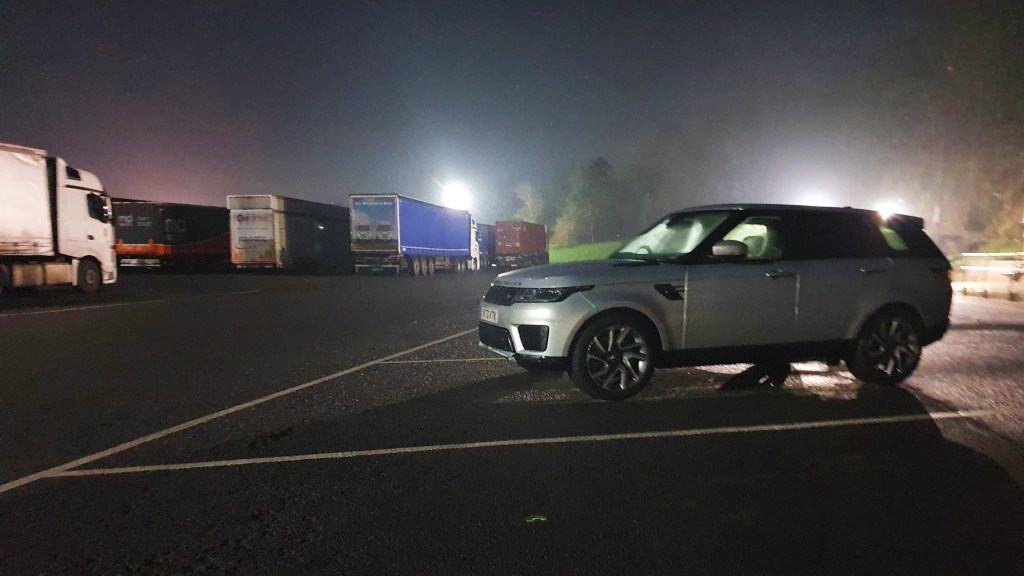
I want to thank Land Rover for the loan of the car, though. Its press team has been incredibly helpful throughout the test and they were very apologetic about the breakdown. At no point was I asked to hide what has happened, and they understood when I said I would have to report the experience truthfully.
They’ve also investigated what went wrong with the car and sent me the following, brief explanation:
“The Range Rover Sport used suffered a loose earthing cable which caused the issue. This is not a common issue and is an isolated occurrence.”
They were also horrified to learn about my experience with Land Rover Assist and promised it has been taken up with the team at the AA. It’s especially concerning for them as my test car’s numberplate is on a list of VIP cars, I was told, something I wasn’t aware of when I called for assistance.
It’s the people in charge of quality control within the engineering teams who really need to pull their fingers out, in my opinion, especially in the run-up to delivering new Range Rover models later this year and next. This particular fault may not be common, and it may well be an isolated occurrence, but the bigger picture, as revealed by Which?, is stark. Reliability does seem to be a big problem.
Land Rover brand loyalty is incredibly high, which means that there’s a lot of leeway when things go wrong, but customer retention and acquisition must be greatly stunted when reports of poor reliability just keep coming.
- Final odometer reading 7,980 miles
- Miles covered during test 4,382 miles
- Indicated average fuel economy at end of test 39.7mpg
- Average prior to Eastnor trip 44.9mpg
This extended test has now concluded. If you’d like to ask a question about the car, please do comment below, but I shall stop checking comments in the next few weeks. I’m also taking a break from Twitter until they get serious about trolling, which I’ve been fortunate to avoid but from which many others suffer.
Related articles
- If you are enjoying this review of the Range Rover Sport P400e plug-in hybrid and want to read more of our long-term car reviews, click here
- You might also be interested in the all-new Range Rover for 2022, which gets upgraded hybrid power, ultra luxury and a date for pure-electric version
- And here’s why Jeremy Clarkson thinks the Volkswagen Touareg R is the closest competitor to the Range Rover


